The magnolia has a rare calming aura that is also self-assured: it is classic, Southern style with a bit of charm, and its shape is such that it looks amazing on the skin. This guide brings together several tattoo designs of magnolias with various placements and styles—from delicate fine line work to fuller shaded compositions—so you can choose a select one based on your clothing, lifestyle, and pain threshold. I will explain the features that make each piece sing, the artist’s possible method (like stencil , needle groupings, and shading logic), plus some styling suggestions so the artwork actually lives with your clothes, not against them.
Overlapping Shoulder Garland With Wilting Flowers
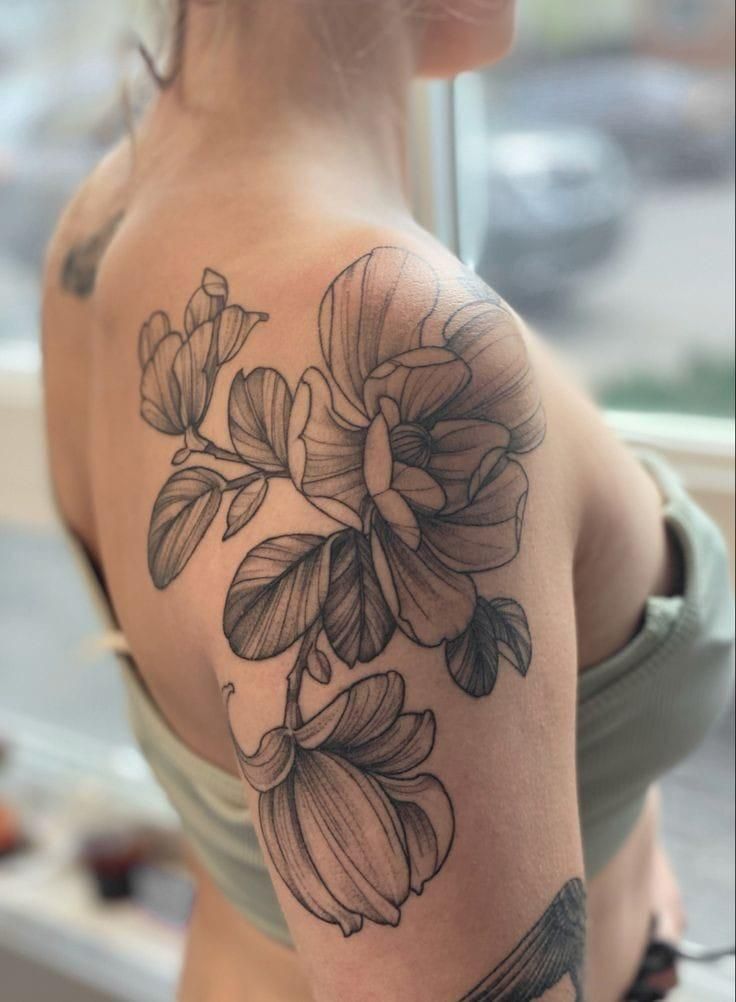
This tattoo design extends from the upper shoulder to the upper arm like a ornament made of plants. The artist uses overlapping petals and large, leaf-rich shapes to give the impression of movement; the lower flower droops like a bell, guiding the viewer’s gaze downward along the arm—excellent idea for anyone who is thinking about getting a partial sleeve later. Shading is a velvet gradient built with tight dotwork and soft whip-shading, which gives the petals that silky, lived-in look without harsh outlines.
Why it works: Magnolias have thick petals; rendering them with subtle grain lines evokes volume without color. If you wanted color , a whisper of pink wash on the inner petals would elevate the realism while keeping the palette refined.
Styling notes: Tops with open necklines—one-shoulder knits, racer tanks, minimal straps—frame the curve. For cooler months, a slouchy cardigan lets the lower bloom peek out. If you’re building toward a sleeve , continue the foliage down the tricep in a fineline “vine” to connect future pieces.
Back-of-Shoulder Branch, Classic Botanical Rendering
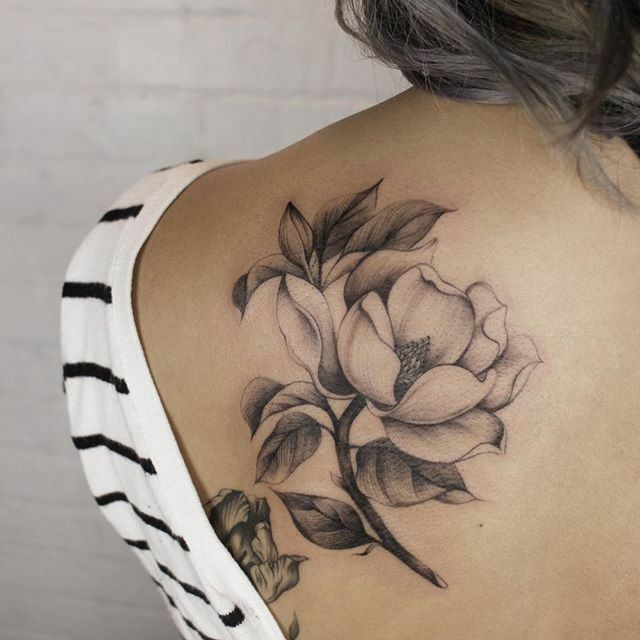
A single branch spans the posterior shoulder blade—quiet and romantic. The petals are rendered with hatched shadows and stippling, while the leaves carry slightly darker midtones for depth. This is a great example of design fine line meets classic botanical illustration: crisp outlines, feathered interiors, and a center stamen detailed enough to read from a few feet away.
Why it works: Back placements need shape memory. The branch angle follows the shoulder’s natural slope, so it looks “native” to the body whether you’re standing or turning.
Styling notes: Backless sundresses, scooped tees, or cut-out sweaters become frames. For events, a low-back slip in ivory or charcoal lets the grayscale pop—think gallery-goer chic.
Airy Three-Stop Composition From Shoulder To Forearm
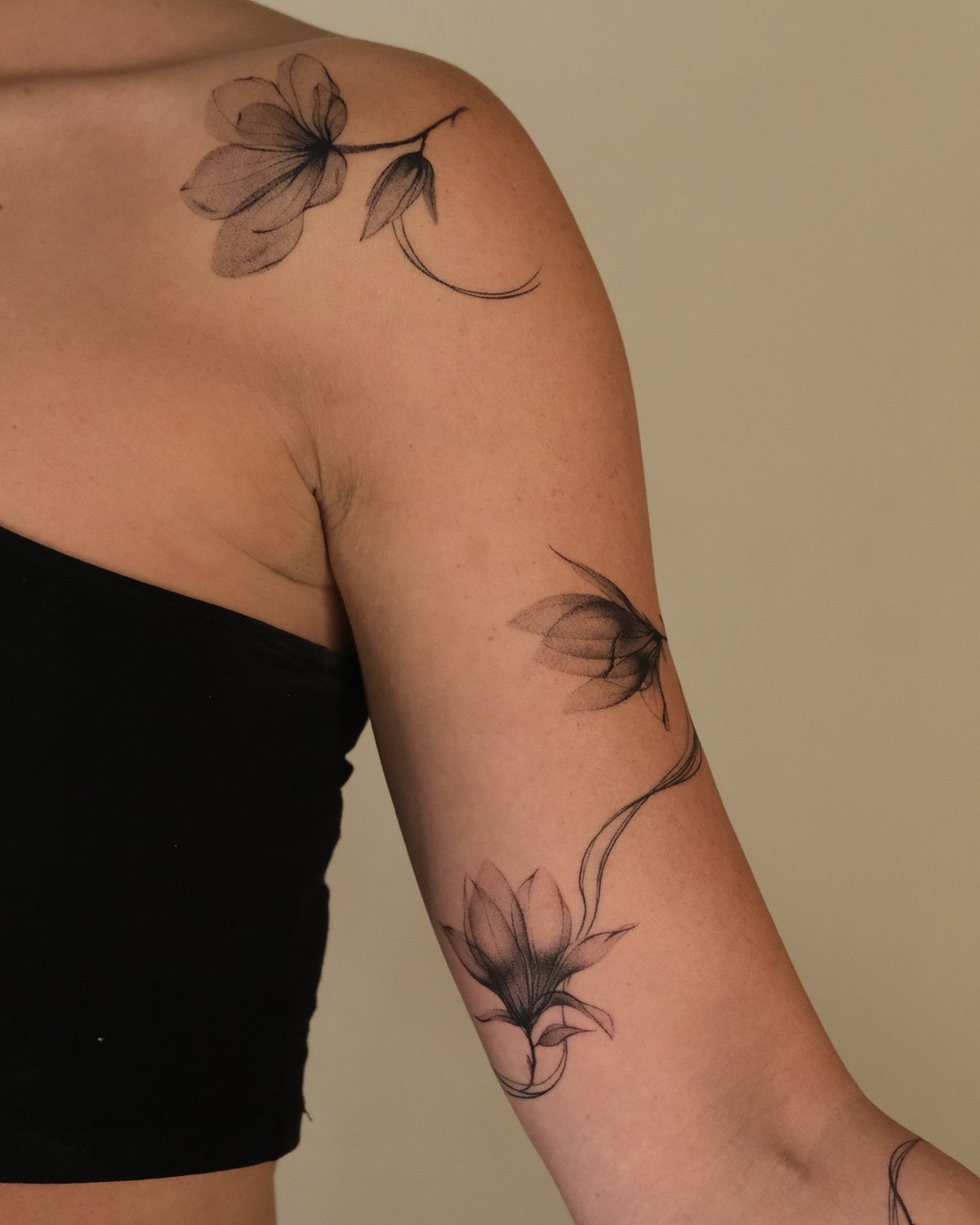
Three ethereal blossoms travel from the front shoulder cap down the outer arm, tied together by a hair-thin stem. The petals are smoky—achieved with a very soft pepper shading and intentional negative space. It’s minimalist without feeling spare, the floral answer to a constellation tattoo.
Why it works: Negative space is the “color.” By resisting heavy outlines, the artist keeps it weightless and modern. It nods to Japanese floral restraint without copying its line economy outright.
Styling notes: Strapless or asymmetric tops let the upper bloom breathe. For streetwear, pair with a cropped bomber so the mid-arm flower flashes at the cuff. Add slim bracelets; they won’t crowd the piece.
Petite Inner-Arm Sprig For Everyday Minimalism
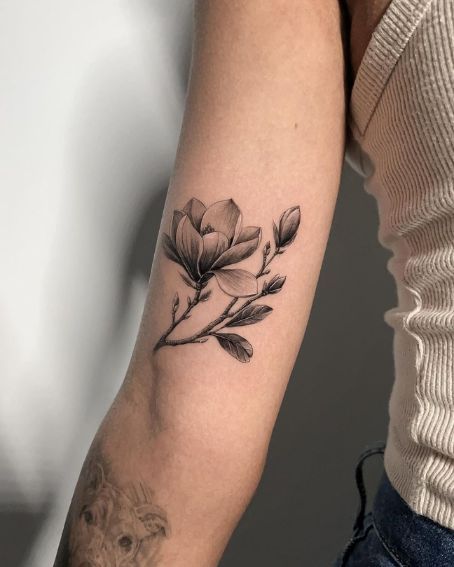
A small branch sits on the inner forearm—intimate territory where tattoos feel like secrets. With tight linework and just-there shading, it’s a study in restraint. Perfect for a first-timer, or for men who want floral ink that reads understated rather than ornate.
Why it works: The inner arm is naturally sheltered from the sun, so fineline work ages more gracefully. The composition also leaves generous skin breaks—room to add a date, initial, or additional bud later.
Styling notes: Sleeveless tanks, rolled shirt cuffs, or a watch worn slightly higher create a clean vignette. If you love color , a micro-wash of dusty pink along the petal bases can be added months later without re-stenciling the whole piece.
Negative-Space Bouquet Wrapping The Elbow
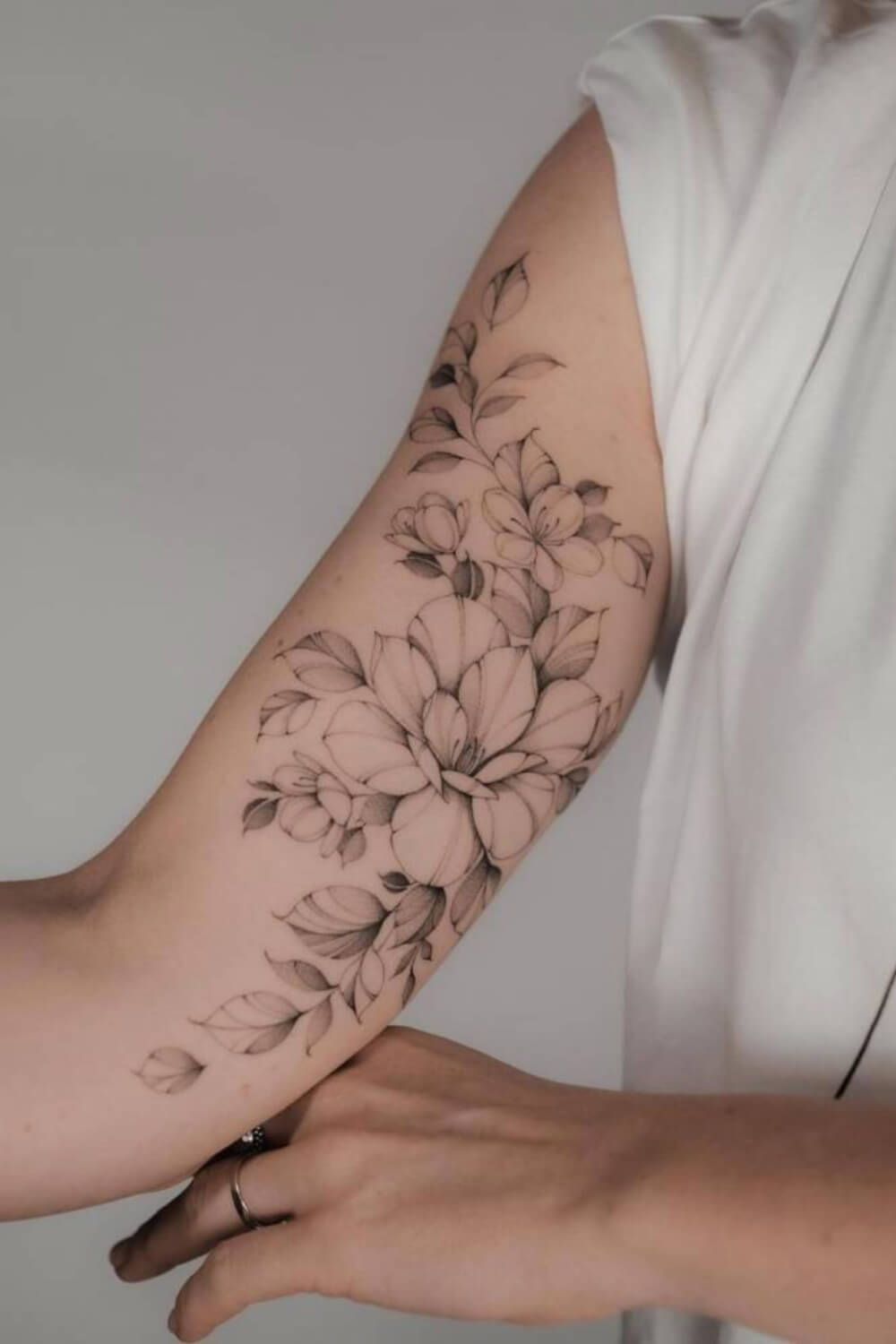
This is the clever one: a magnolia cluster that skirts the elbow with leaves radiating into the bicep and forearm. The artist leverages negative space to suggest petals while building leaf contrast with layered stipple—think steel-wool softness rather than marker-dark. It’s a beautiful “pivot” design if you’re moving toward a half- sleeve ; the elbow becomes a quiet clearing amid detail.
Why it works: Movement. The leaves angle like streamers in wind, which keeps the elbow (a notoriously tricky zone) from feeling blocky.
Styling notes: Boxy tees or rolled-sleeve poplin shirts showcase the wrap. Jewelry lovers: slim bangles echo the ring of leaves without covering them.
Forearm Cascade With Deep Contrast
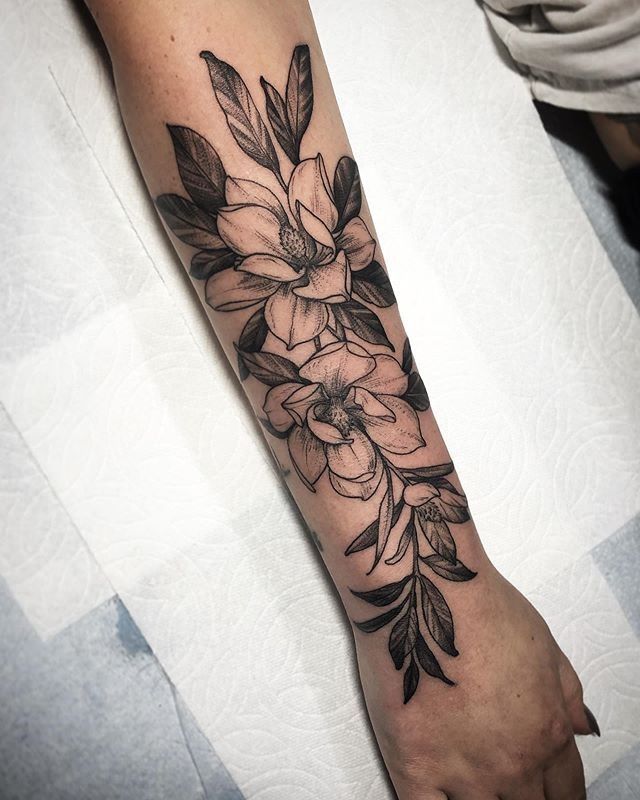
A vertical run of blossoms and leaves pours down the forearm, high-contrast and editorial. Line weights vary—thicker outlines on foreground petals, hairlines on background leaves—so the piece reads crisply even in low light. The tonal range pushes toward charcoal, a look sometimes called “ steel blackwork” by artists who favor darker midtones.
Why it works: A long forearm canvas rewards rhythm. The alternating bloom-leaf-leaf sequence creates a natural beat—no dead zones, no visual clogs. If you’re into heritage aesthetics, this layout can also hybridize with American traditional accents (sparrows, banners) below the wrist without clashing.
Styling notes: Monochrome outfits let the grayscale shine: black denim, white oxford, leather cuff. For dressier moments, a cropped blazer reveals the floral tip at the wrist—subtle drama.
Sculptural Thigh Magnolia With Carved Line Textures
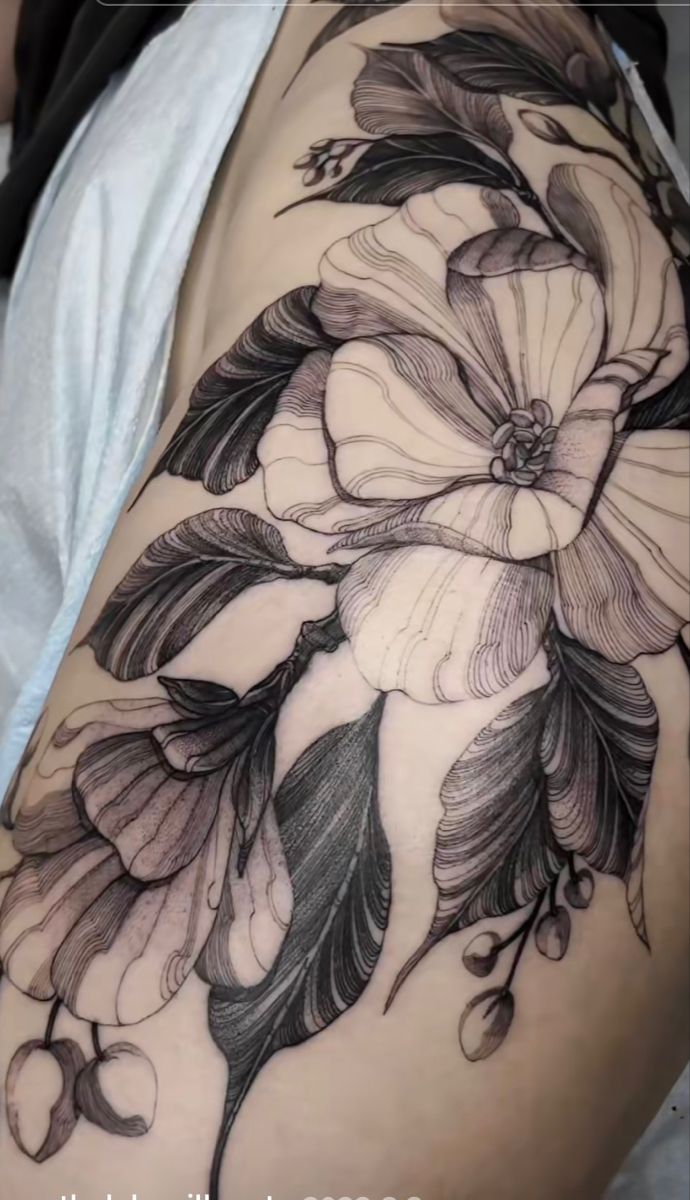
This large-scale composition stretches along the thigh like a botanical relief. The petals are modeled with long parallel strokes, almost woodcut in spirit, while the leaves shift to darker cross-hatching for a velvet “ steel blackwork” contrast. You can see how the artist likely built a precise stencil , then carved depth with slow whip-shading so each grain line reads. It’s a museum-grade design that rewards close viewing.
Why it works: Big thighs deserve big shapes. The petal ribs echo the leg’s natural sweep, so the flower looks alive when you walk. If you ever want color , a tea-stain sepia or blush pink wash inside the petal bases would stay elegant.
Style ideas: Bias-cut skirts, slit midi dresses, high-cut swimsuits—anything that lets the curves of the piece breathe. Boots + oversized blazer add a modern, slightly Japanese minimal feel to the look.
Classic Upper-Arm Cluster With Healed-Friendly Stippling
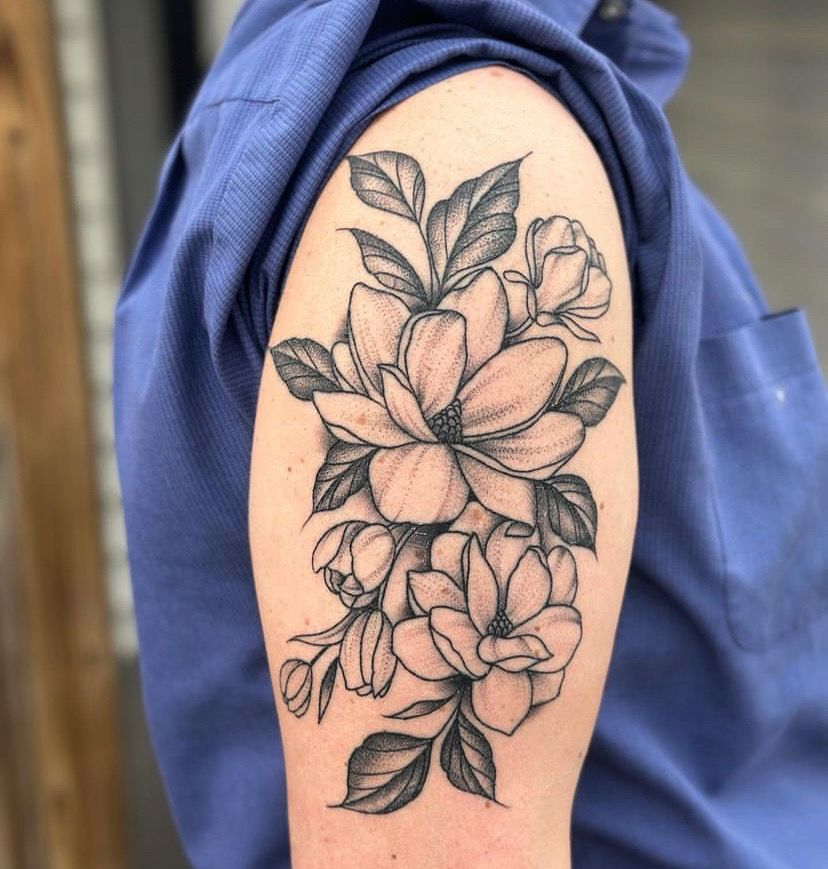
A trio of blooms and several buds form a vertical bouquet on the outer arm. The artist balances crisp outlines with soft stipple midtones across the petals and darker leaves to frame the centers. It reads timeless—floral realism with a whisper of traditional tattoo grammar in the bold leaf edges, an easy bridge if you like American traditional elements elsewhere.
Why it works: The arrangement narrows toward the elbow, which visually slims the upper arm. It’s also brilliant for gradual additions—add a name ribbon below later without crowding the composition.
Style ideas: Rolled short sleeves, chambray shirts, varsity knits. For men who prefer cleaner silhouettes, this is a refined entry into magnolia tattoos without going full sleeve .
Graphic Linework Stack Along The Tricep
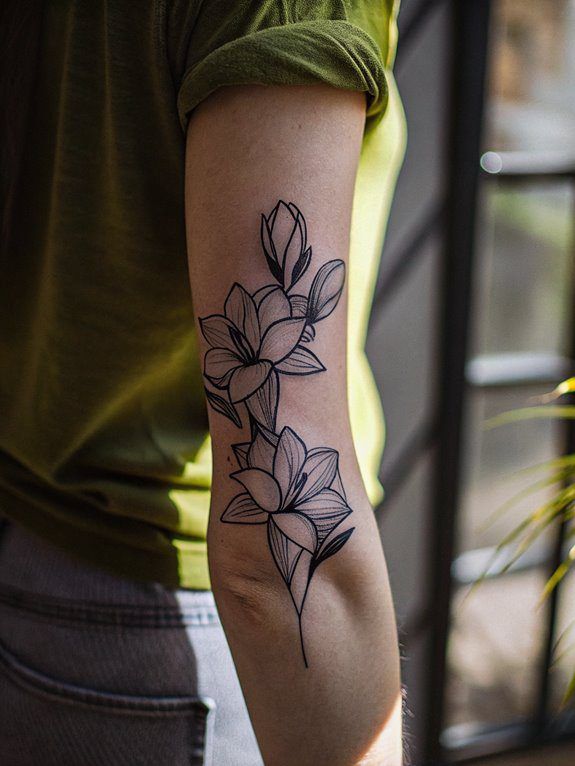
Tall, graphic blooms climb the back of the arm with confident, uniform lines. Shading is minimal; the piece relies on silhouette and negative space—pure fine line attitude with just enough interior striping to suggest petal turn. Because it clears the elbow ditch, it heals fast and stays crisp.
Why it works: The narrow stem acts like a spine for future additions. You could evolve this into a light botanical sleeve by threading more buds toward the wrist.
Style ideas: Cap-sleeve tees, racer tanks, or a sleeveless trench. Pair with delicate chain bracelets—thin metal echoes the fineline rhythm.
Shoulder-Cap To Half-Sleeve Gardenia-Meets-Magnolia Mix
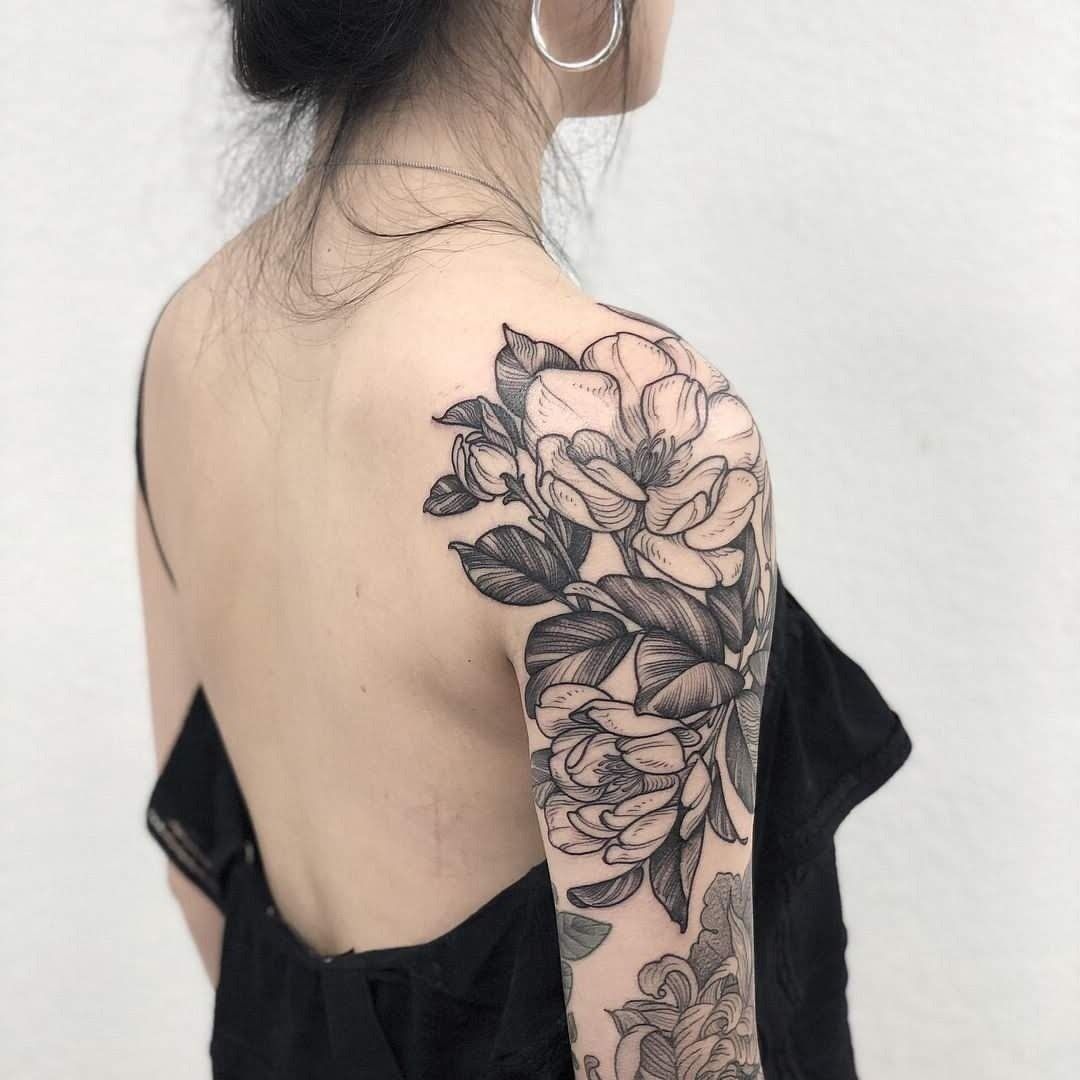
A lush shoulder cap spills into the upper arm, engineered like a floral pauldron. Leaves carry the darkest values while petals stay luminous through controlled dotwork; the result is couture-level body armor—soft, but strong. There’s a whisper of Southern romance in the fullness, yet the line economy keeps it contemporary.
Why it works: Perfect anatomy mapping. The top bloom crowns the deltoid; secondary flowers ladder down the bicep, a natural path for a future half- sleeve .
Style ideas: One-shoulder knits, slip dresses with spaghetti straps, or an open-back jumpsuit. For cool weather, a slouchy cardigan lets the cap peek over the edge.
Forearm Vine With Delicate Buds And Open Petals
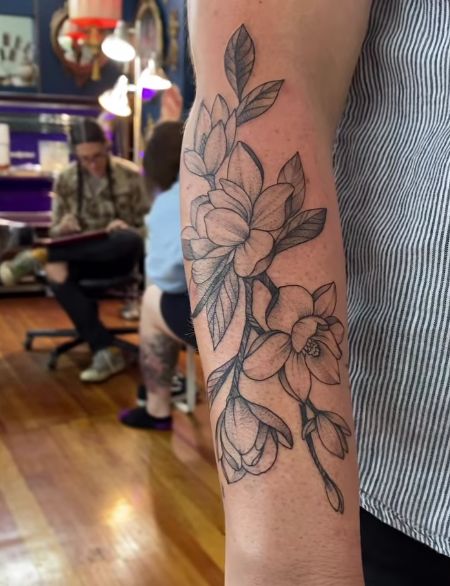
This is the “everyday” forearm design —clean outlines, airy dot shading, buds leading the eye downward. The interior petal tones are light enough to age gracefully on a sun-exposed area. If you’re a fan of design fine line , ask your artist to keep needle groups small (3RL/5RL) for those hair-thin details around the filaments.
Why it works: The staggered bloom-bud rhythm prevents visual heaviness and makes room for a date or micro-symbol without disrupting flow.
Style ideas: Striped button-downs with rolled cuffs, denim jackets, or a thin leather watch layered above the lowest bud.
Dotwork Duo With Playful Motion
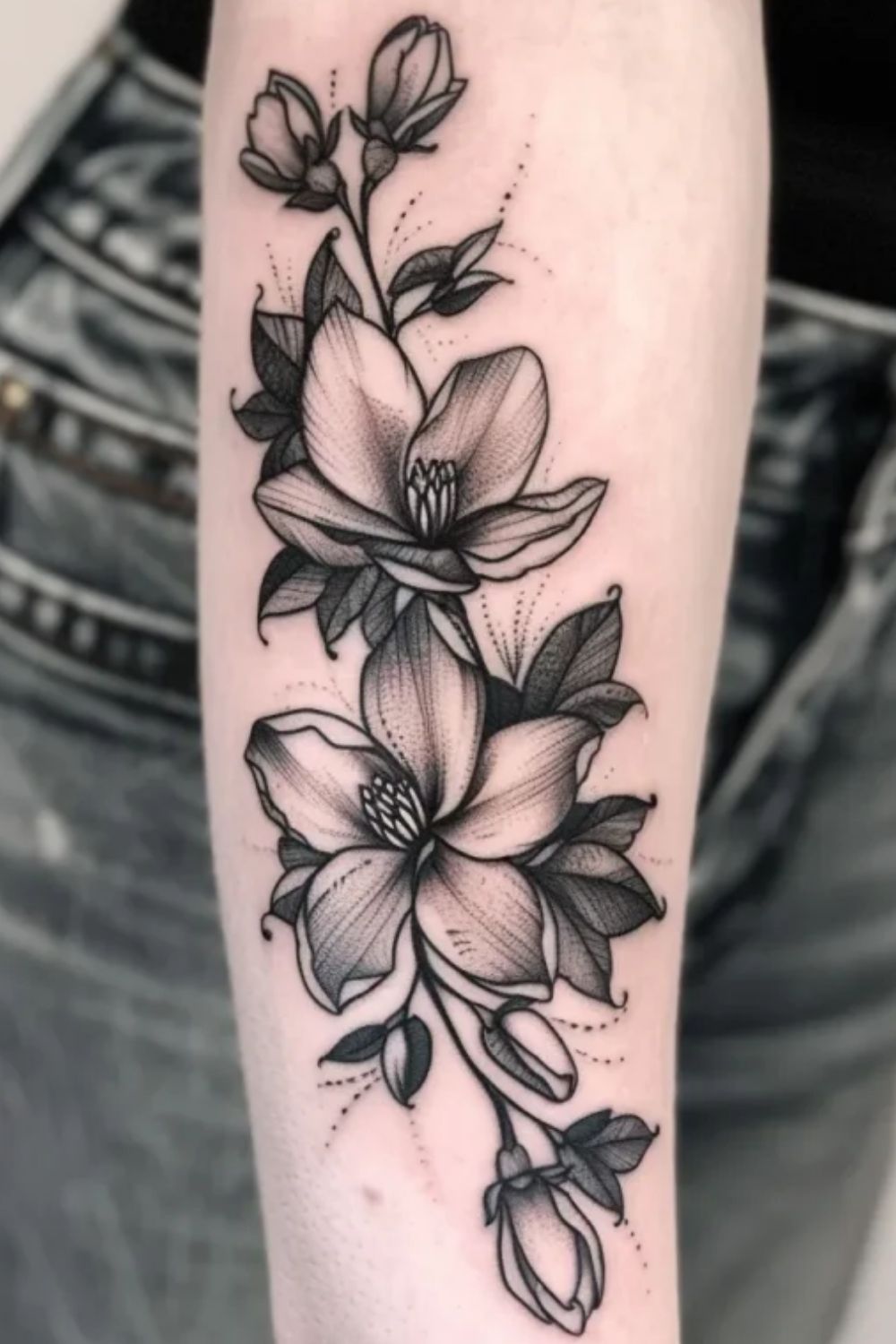
Two blossoms and a cluster of buds curve along the inner forearm. The stipple is meticulous—tiny dots close together for shadow, then breathing room toward the highlights—so the petals feel soft to the touch. Those dotted “trailing” accents add motion without clutter, a subtle nod seen in modern European botanical studios covered by Tattoo Life and Inked Magazine.
Why it works: High legibility from across a room; close up, the grain reads like silk. It’s an adaptable base if you ever layer in micro- color later.
Style ideas: Cropped cardigans, bracelet stacks, or a minimalist cuff. Works beautifully with monochrome outfits where grayscale tattoos become the texture.
Outer-Arm Magnolia Spray With Confident Lines
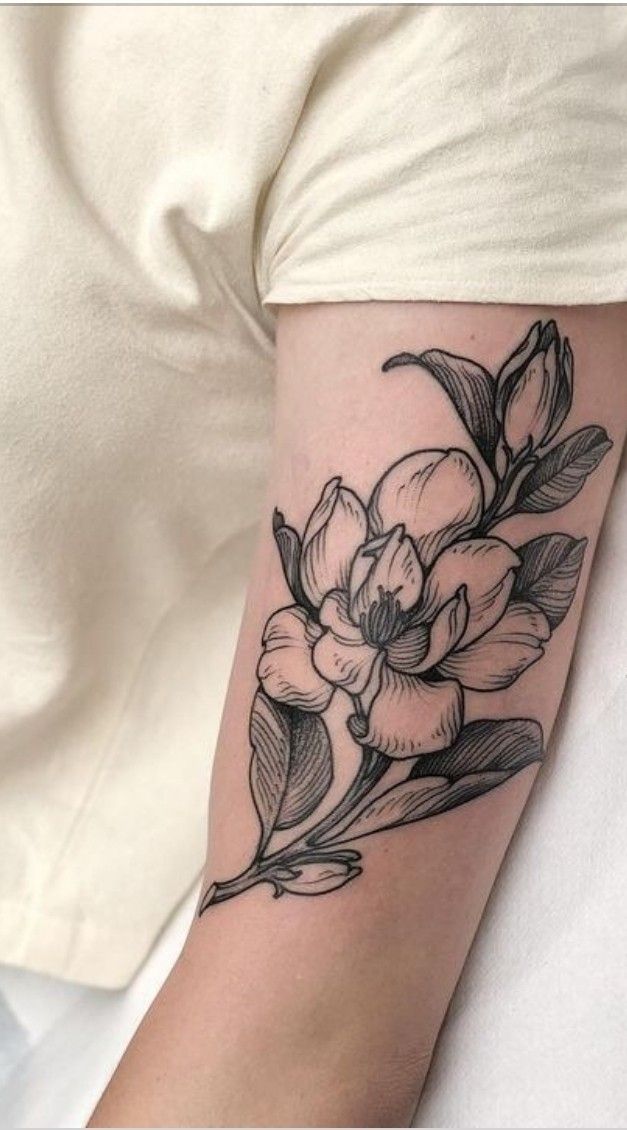
A tidy vertical bouquet sits on the outer arm, built from bold contours and leaf hatching that pushes the blossoms forward. The petals carry light pepper shading; the leaves go darker to frame the centers. It’s a versatile design that works for anyone—elegant on its own, or as a cornerstone if you’re plotting a future forearm sleeve .
Why it works: Clear silhouette and balanced negative space keep the piece readable from a distance—great for everyday sleeves and rolled cuffs.
Style ideas: Short-sleeve tees, chambray shirts, and denim jackets. For men , pair with a leather watch; the hardware echoes the tattoo’s graphic rhythm.
Smoky Fineline Stem On The Tricep
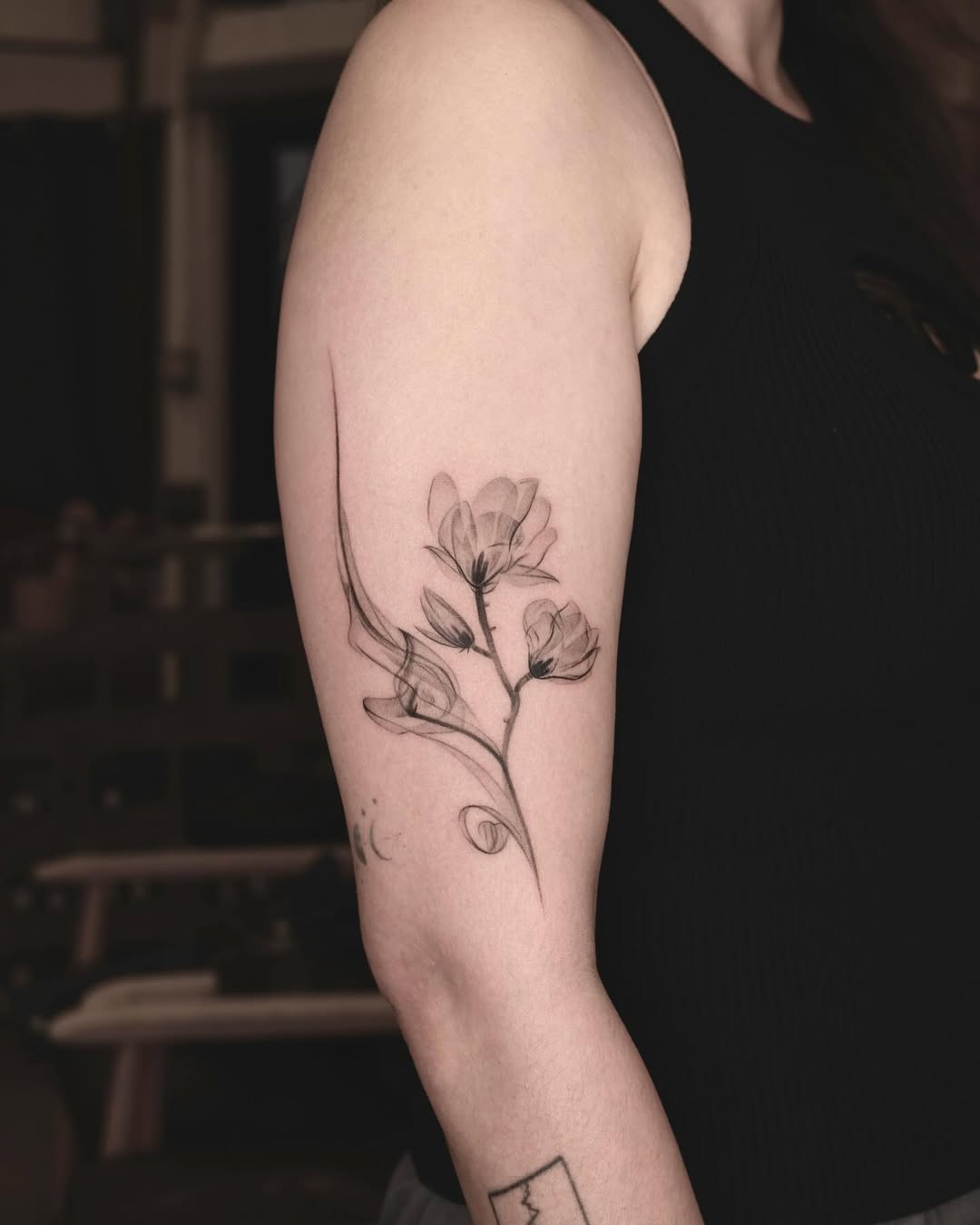
This airy branch leans into fine line minimalism. The petals look misted on, with soft charcoal transitions and a whisper-thin stem that snakes toward the elbow. It nods to Japanese restraint—let the petals breathe, let the line do the talking.
Why it works: Negative space is the highlight; it heals beautifully and layers well with future micro-symbols.
Style ideas: Racer tanks, cap sleeves, or a sleeveless trench to frame the long sweep of the stem.
Shoulder-Cap Bouquet With Berries & Botanical Stippling
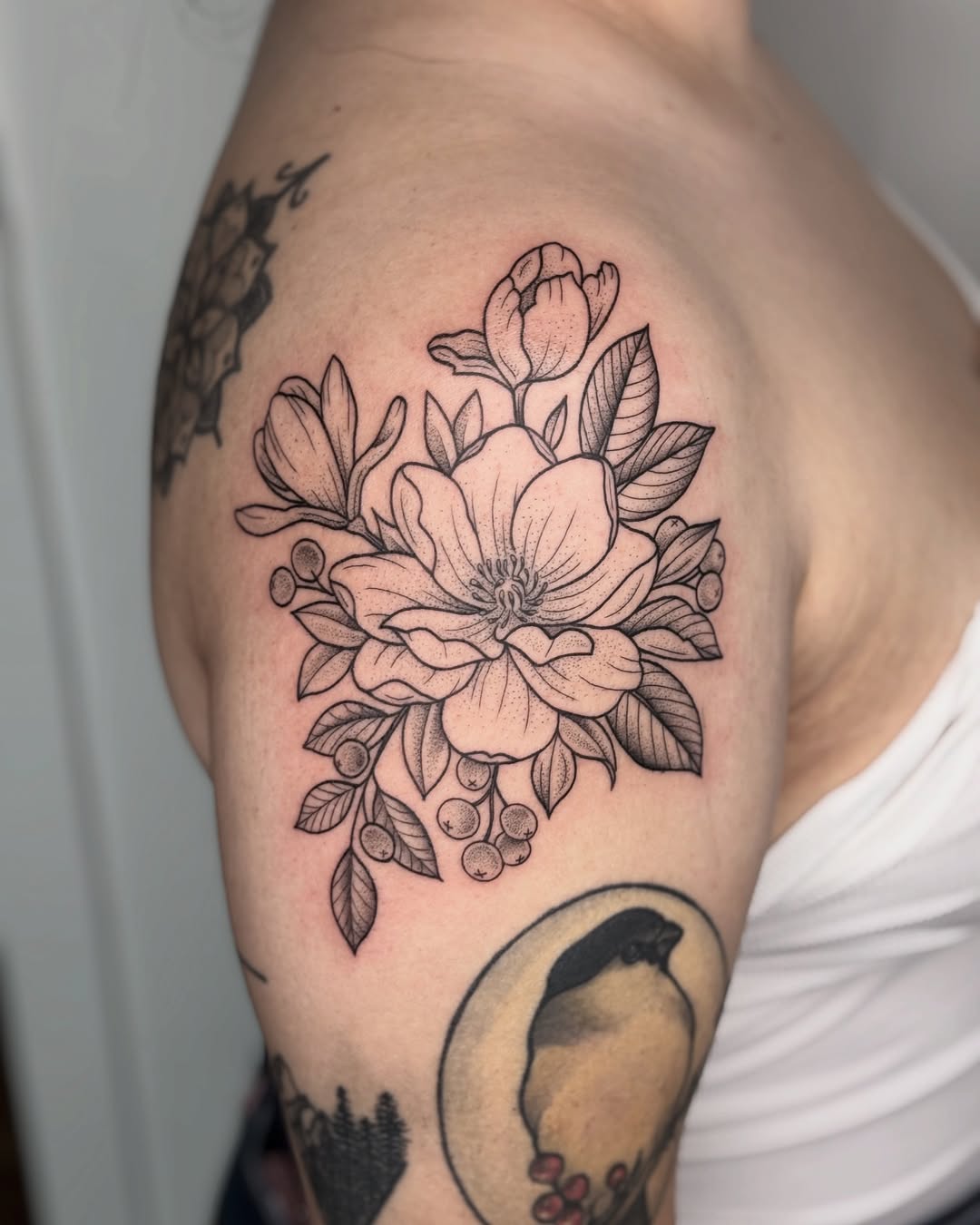
A lively cluster crowns the shoulder , complete with buds and berry accents. Outlines stay crisp while interior tones are stippled—classic botanical vibes with a whisper of traditional tattoo grammar in the leaf edges. Expect flattering coverage across the deltoid and easy expansion into a half- sleeve .
Why it works: The circular bloom anchors the shoulder cap; satellites (buds, berries) keep the edges playful rather than blocky.
Style ideas: One-shoulder knits, spaghetti-strap slips, and open-back tops.
Micro Color Magnolia—A Pink Whisper On The Inner Arm
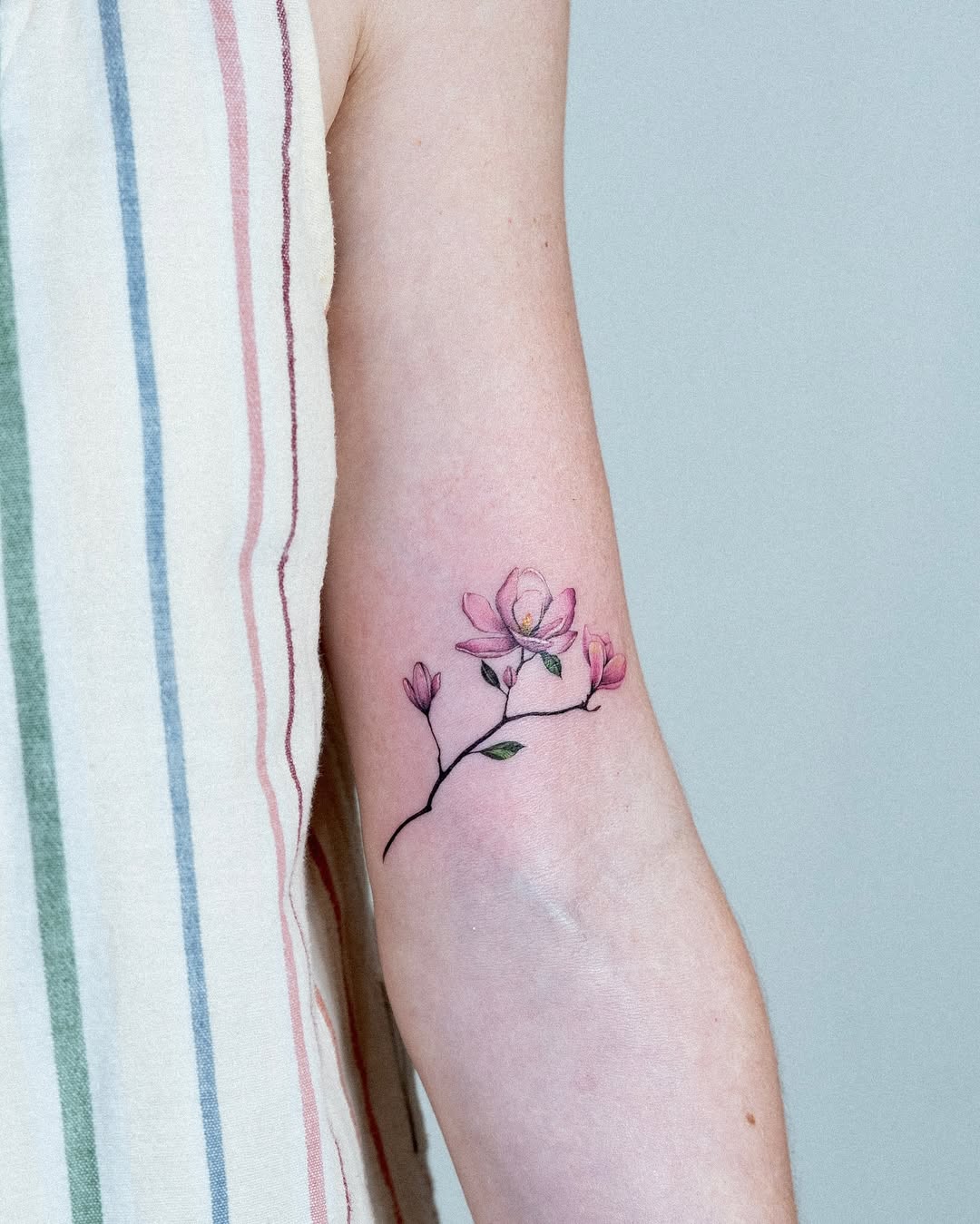
A tiny branch with color blooms—gentle pink petals, micro leaves, and a hairline stem. The painterly finish rides on a precise stencil and careful needle control; it’s the sweet spot for fans of design fine line who want something that reads romantic, not sugary.
Why it works: Inner-arm placement preserves color; minimal saturation keeps the piece light and modern.
Style ideas: Striped linen tops, rolled sleeves, delicate gold bracelets to echo the soft palette.
Moody Black-and-Gray Branch From Wrist To Elbow
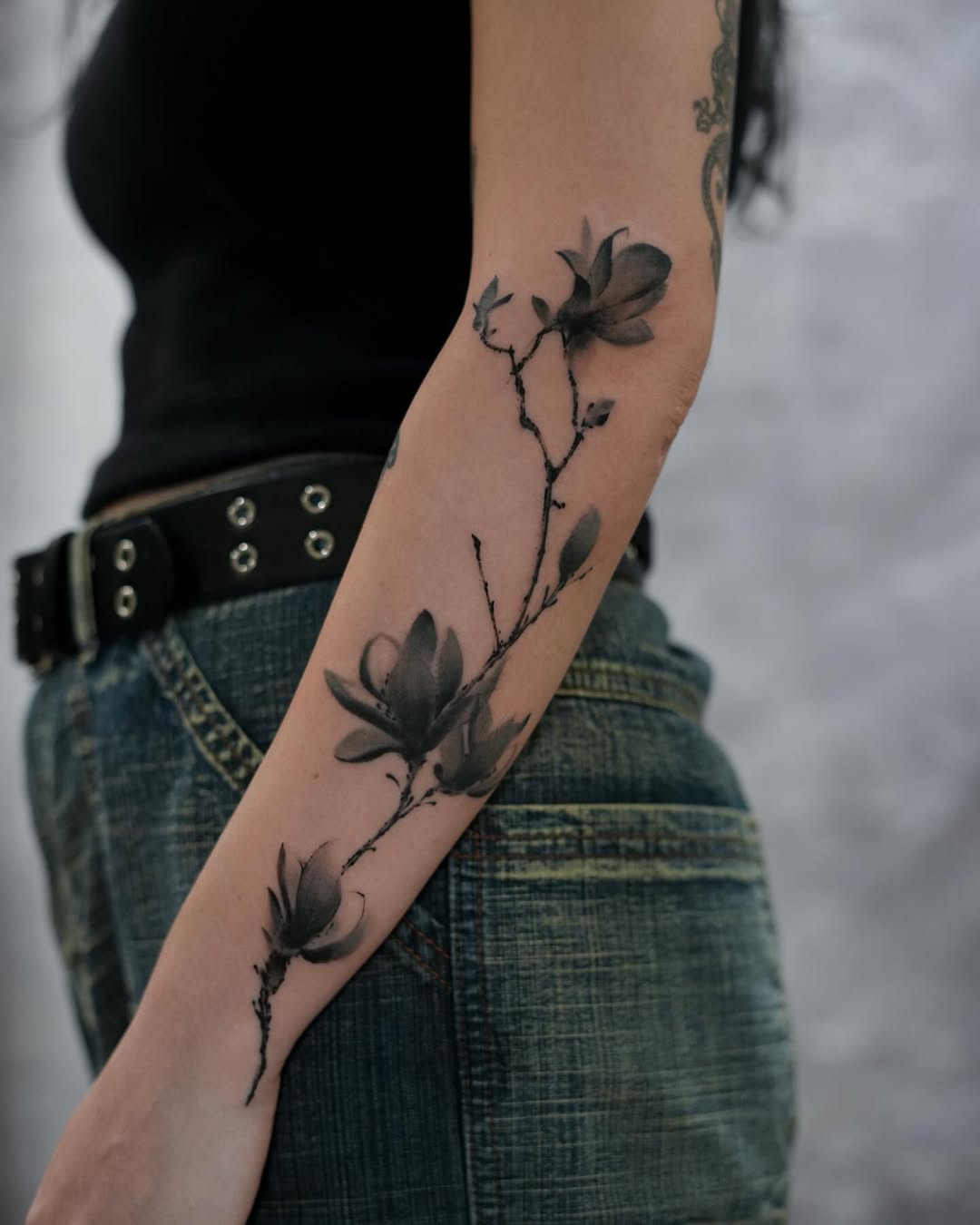
A long, twiggy stem carries three smoky blossoms up the forearm. Petals are foggy mid-gray—think “ steel blackwork”—while the branch stays crisp for contrast. It’s a cinematic look that pairs nicely with denim and leather, and it’s a natural backbone for a minimalist botanical sleeve later.
Why it works: The alternating bloom-gap-bloom rhythm keeps the arm from feeling crowded and elongates the silhouette.
Style ideas: Slim bangles or nothing at all; let the grayscale be the texture of the outfit.
Two-Bloom Forearm Study With Stipple Depth
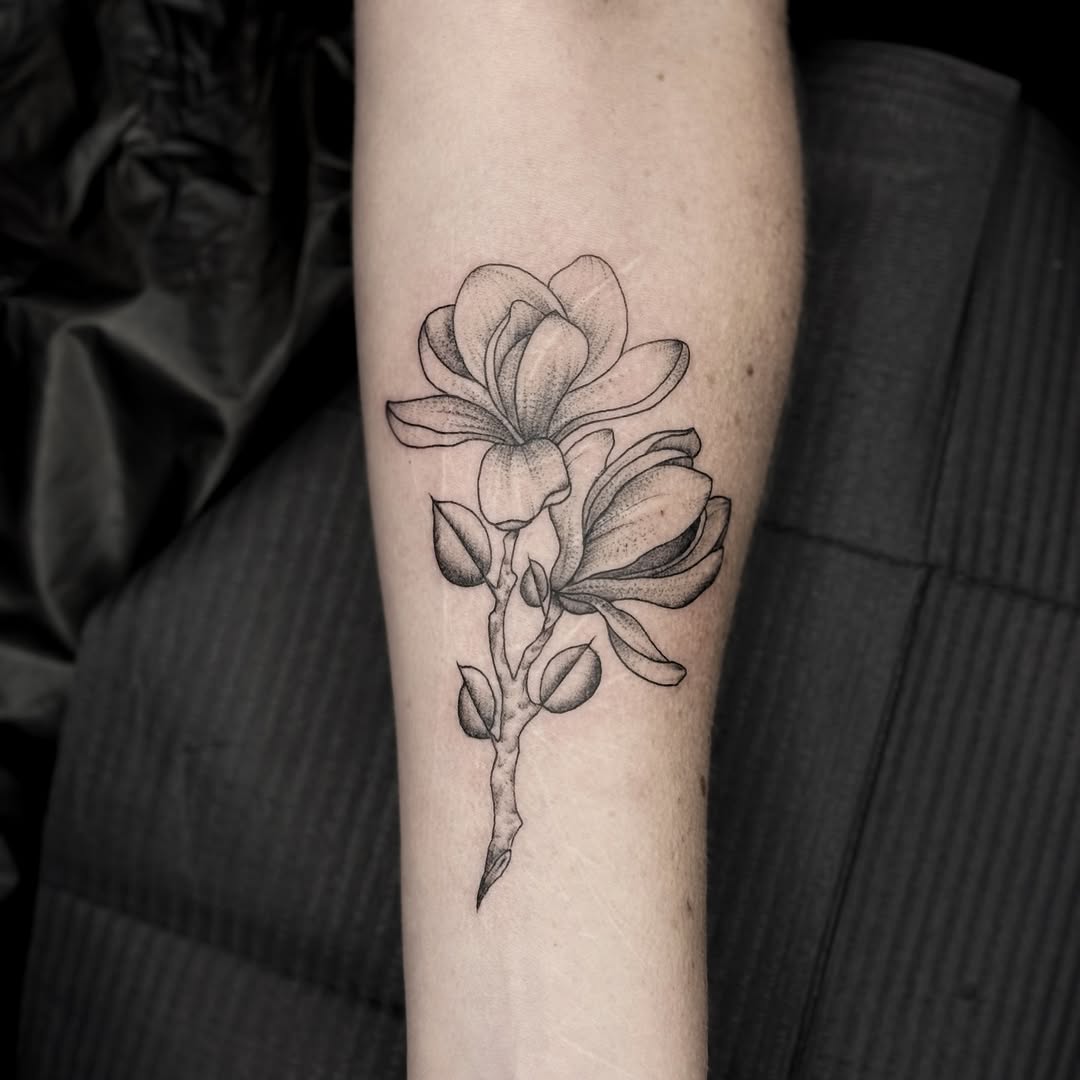
Two open blossoms perch on a short branch, their interiors modeled with delicate dotwork. Leaves carry the darker tones so the petals stay luminous. It’s tidy, readable, and endlessly wearable—ideal for first-timers or for men who want refined florals.
Why it works: Balanced line weights and controlled stipple give it museum-catalog calm without losing warmth.
Style ideas: Cuffed oxfords, knit polos, or a field jacket. Add a slim cuff above the top petal for a polished frame.
Minimal Magnolia At The Ankle, Drawn Like Smoke
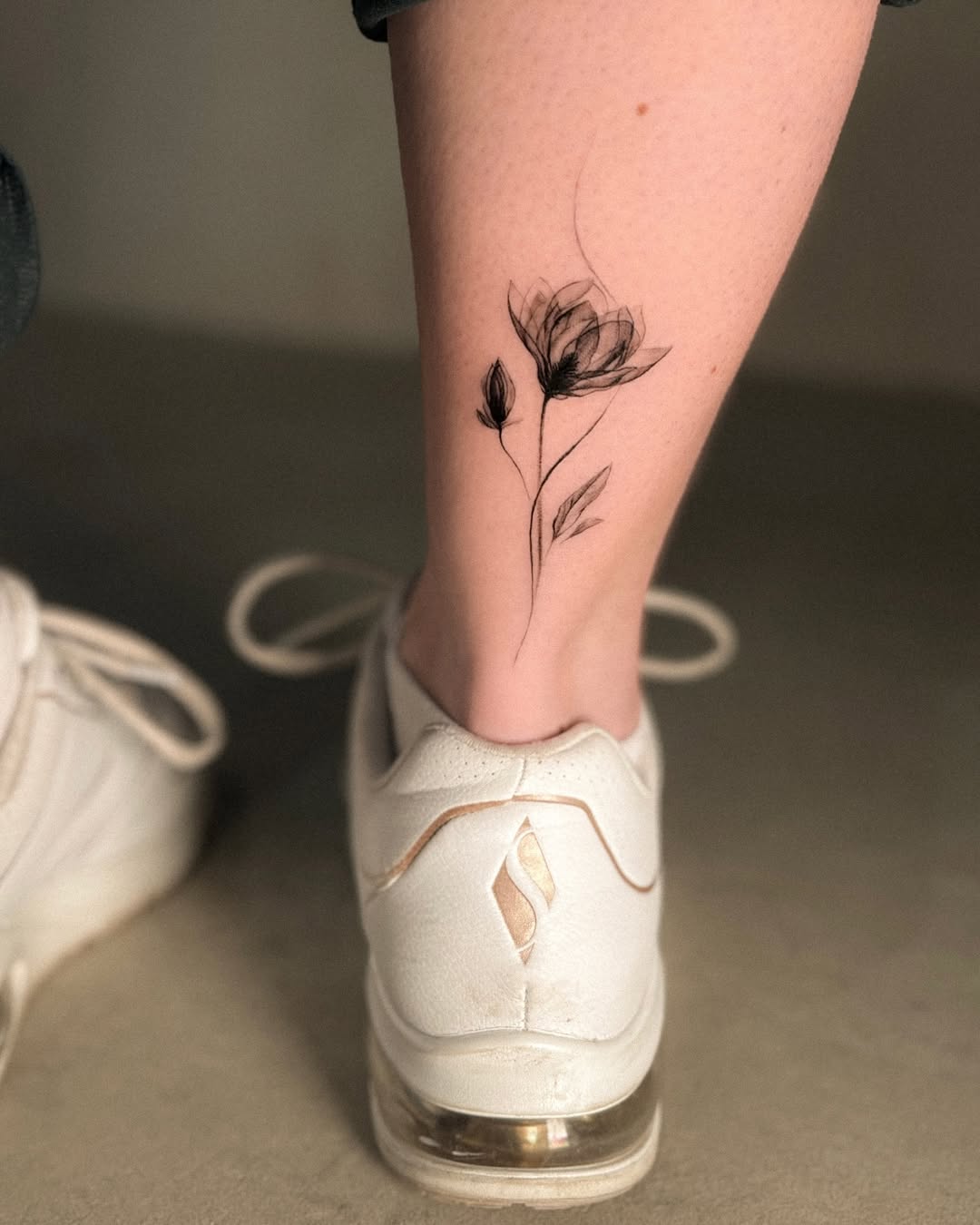
Feather-light petals drift upward on a hairline stem; the bloom feels sketched in air rather than packed with ink. This is fine line poetry: soft charcoal fades, micro leaves, and just enough contour to read as a magnolia without heaviness. Great for first-timers or anyone who wants simple elegance that peeks between sneakers and cropped trousers.
Why it works: Ankles move constantly; the airy value range prevents blobby healing. Ask your artist for a translucent stencil and low-voltage passes to keep that misty edge.
Style ideas: Low socks, rolled jeans, ballet flats—let the negative space breathe.
Spine-Kissing Back Stem With Buds And Breeze
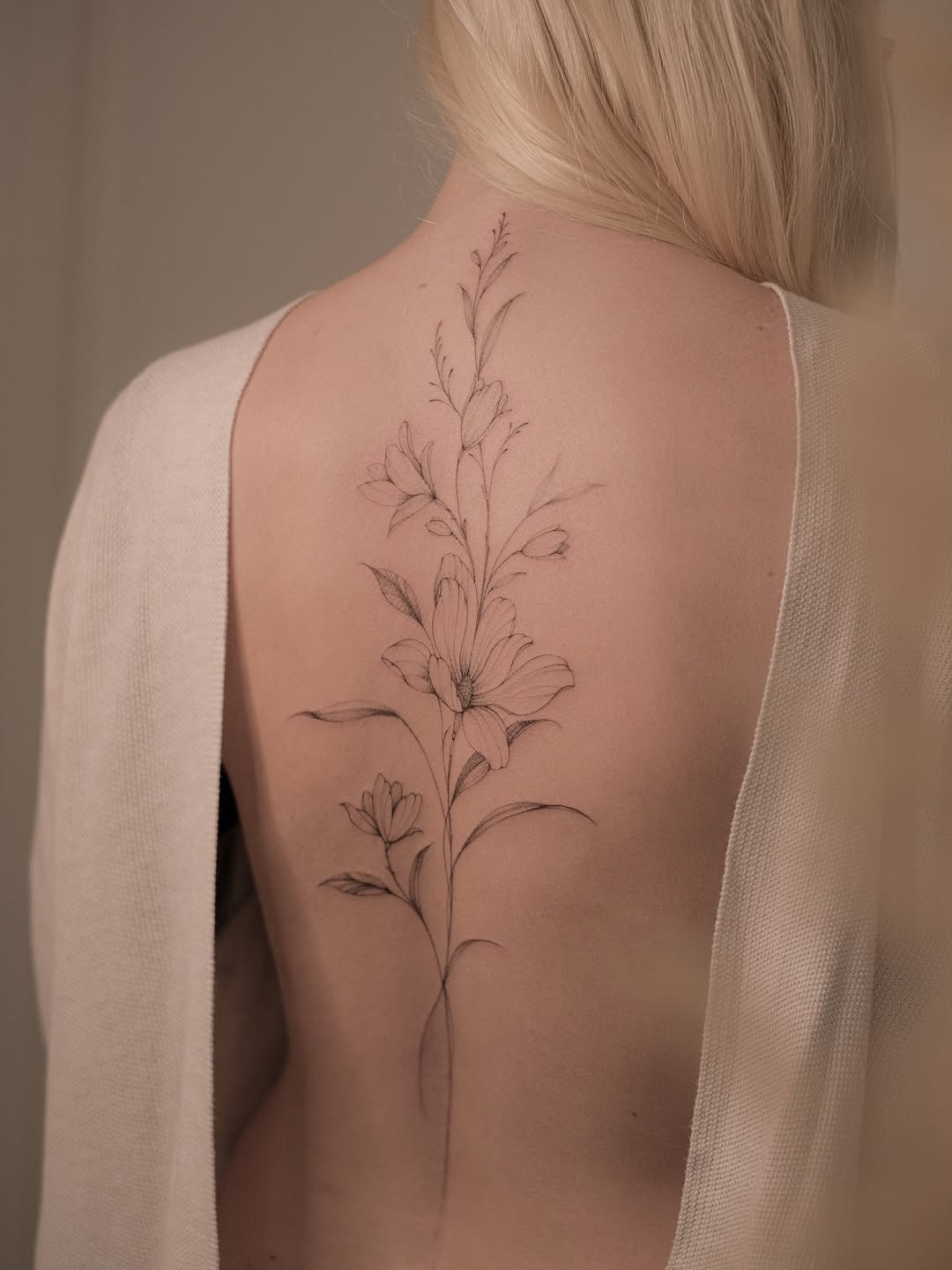
A slender botanical climbs the mid- back , balancing one open flower with supporting buds. Line weights whisper; shading is almost entirely dotwork, the hallmark of design fine line . It’s a confident gesture that elongates the torso and looks couture under an open-back sweater.
Why it works: Vertical placement echoes the spine’s architecture; the leaves flare laterally for motion without crowding the scapula.
Style ideas: Backless knits, silk camis, or a blazer with a deep center slit.
Micro Color Magnolia At The Collarbone
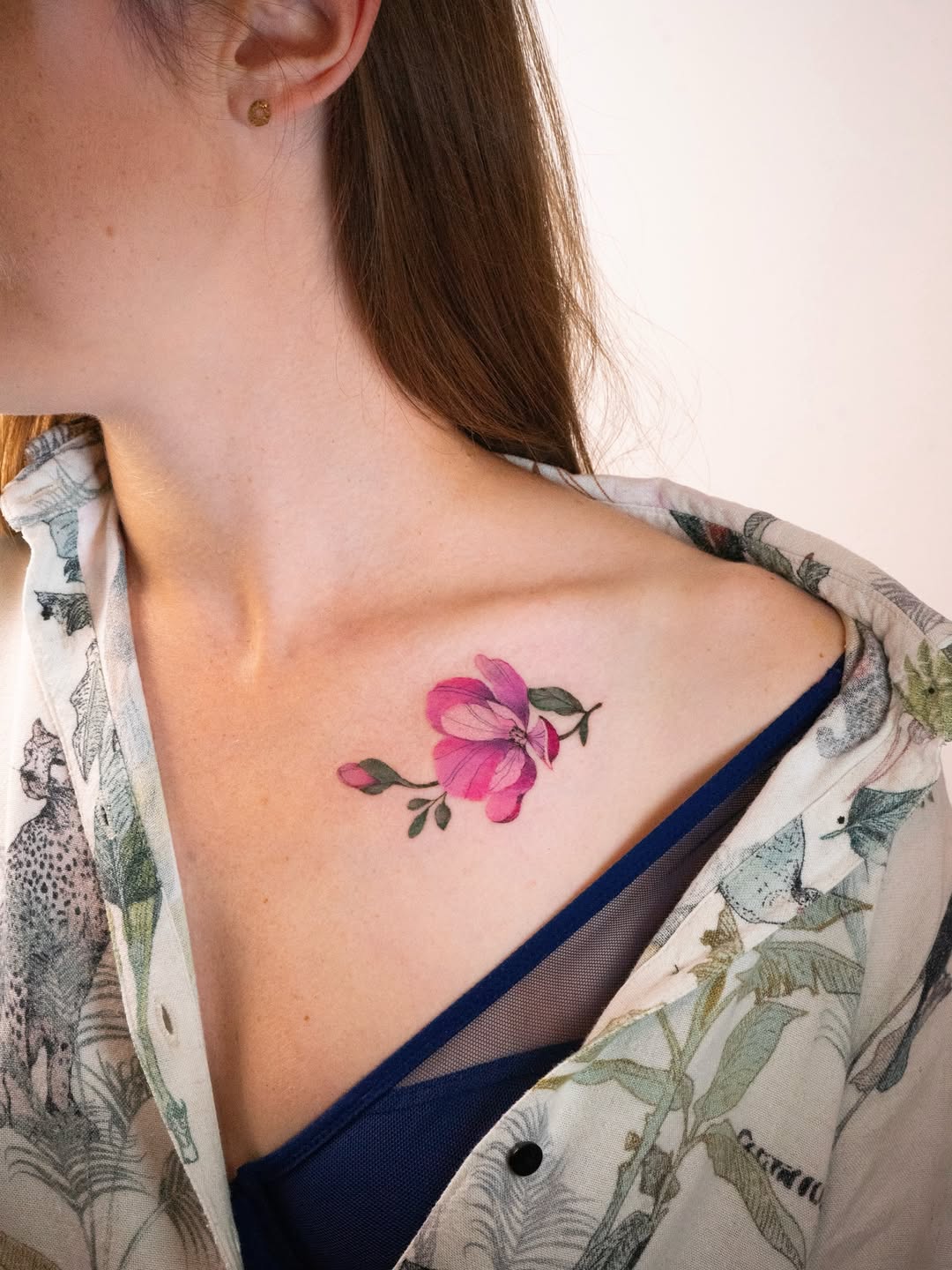
A pocket-sized bloom sits at the clavicle, saturated in candy pink with tiny olive leaves. The painterly color packing keeps the petals glossy; a crisp outline ensures longevity in a high-motion area. Romantic without tipping into sweet, and easy to pair with existing blackwork.
Why it works: The collarbone’s natural notch frames small compositions beautifully. A miniature that still reads from across the room.
Style ideas: Open shirts, thin chains, off-shoulder dresses—let the hue be the accessory.
Ink-Wash Magnolia With Calligraphic Stem
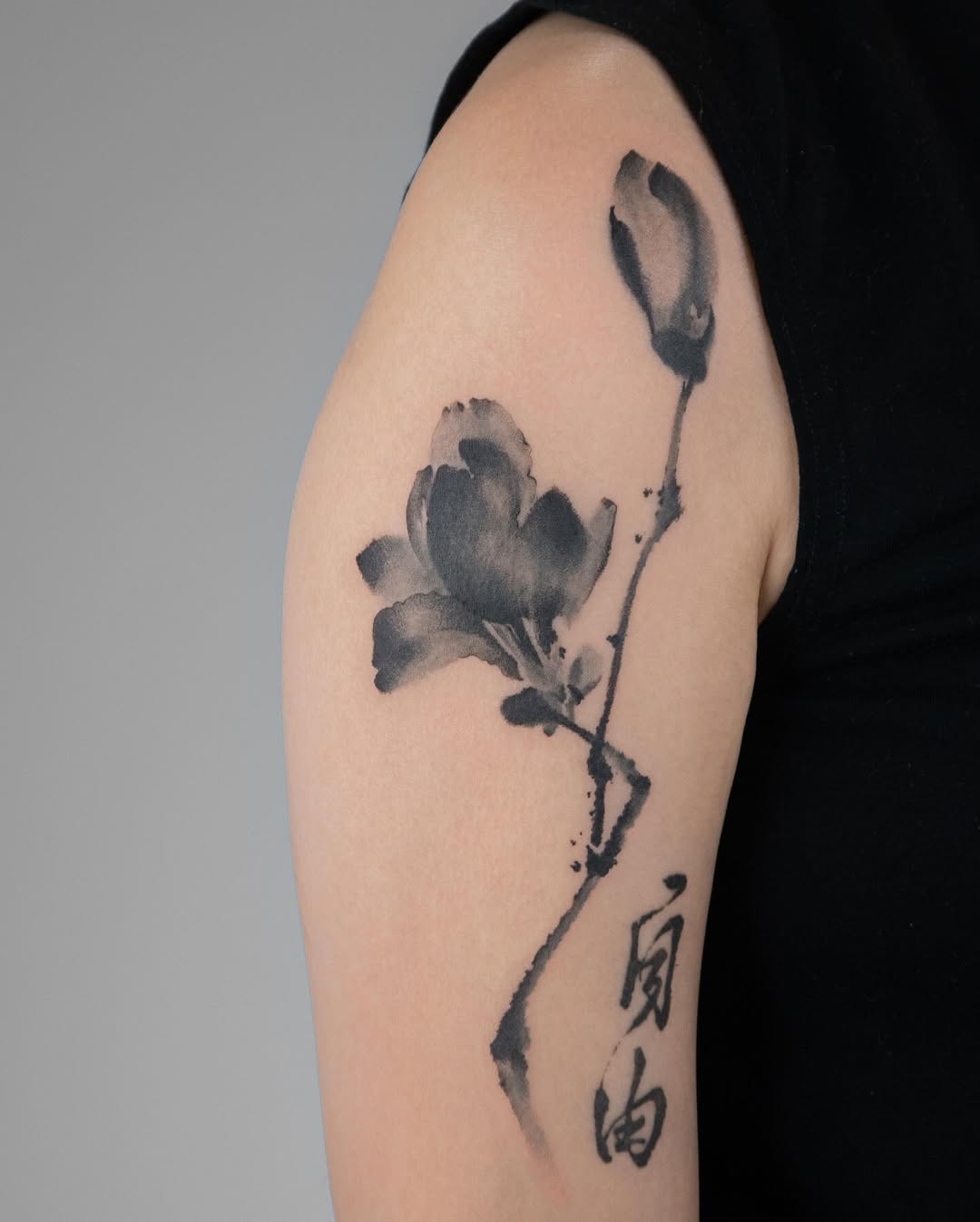
Here the artist borrows from sumi-e: blurred ink petals, splashy transitions, and a calligraphic branch that feels written, not drawn. It’s modern Japanese influence without clichés—no heavy outlines, just flowing gesture and soft steel gray pools.
Why it works: Big tonal blocks read powerfully on the upper arm and age gracefully. Pair with crisp line pieces elsewhere for a considered contrast.
Style ideas: Sleeveless black tops, wide-leg trousers, minimalist jewelry.
Hyper-Saturated Pink Cluster On The Shoulder Blade
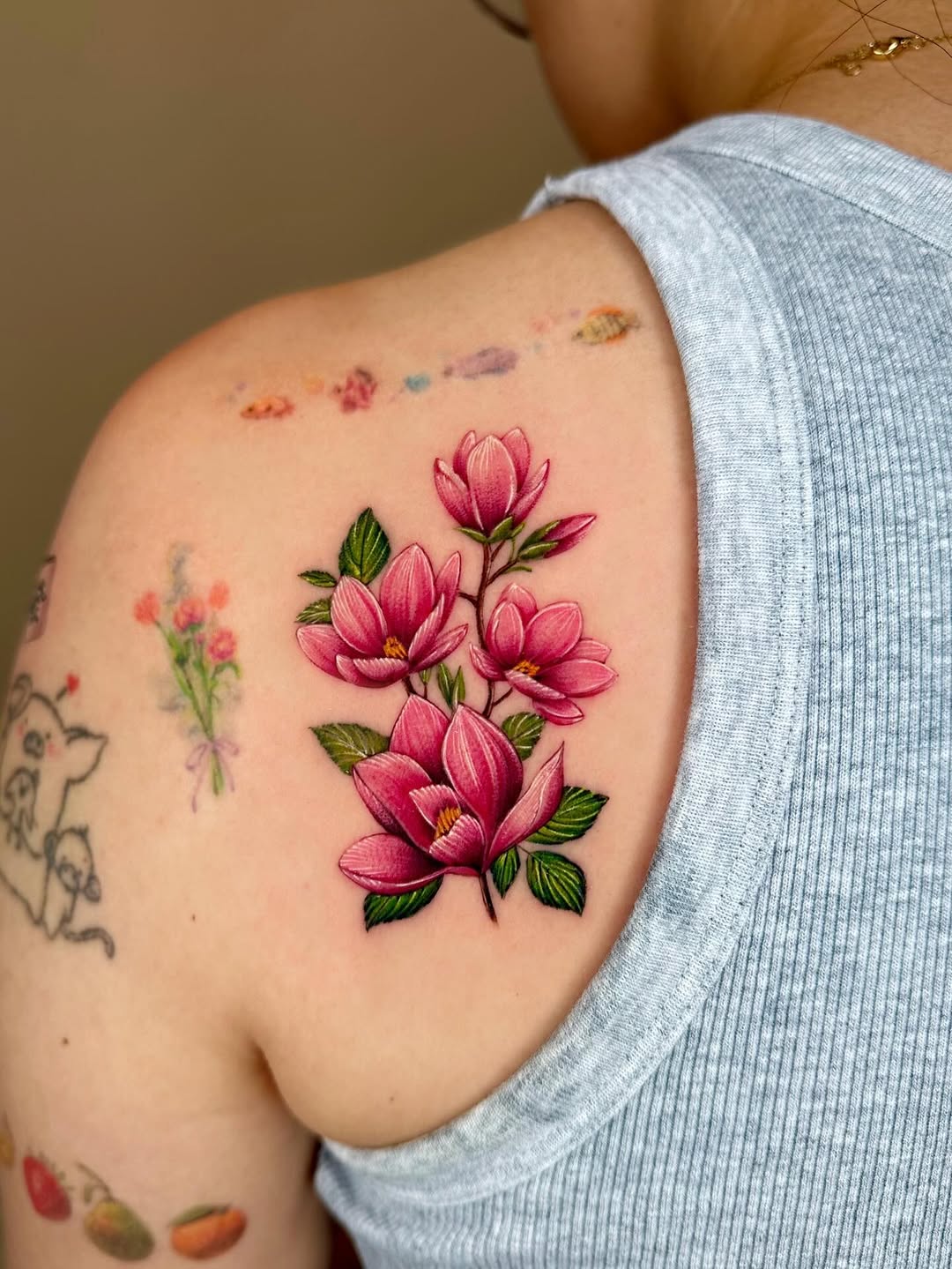
Four hot- pink blossoms stack into a tight bouquet, each petal edged with high-value highlights and tiny yellow stamens. Leaf greens are cool and dimensional, turning this into a postcard of Southern spring. It’s unabashedly color —joyful, but polished.
Why it works: Compact massing keeps the pigment dense and durable; the shoulder blade gives a wide, low-friction canvas for bright work.
Style ideas: Racerback tanks, sundresses, and denim jackets—let the palette pop against heather gray or white.
Shoulder-Wrap Vine With Petals In Motion
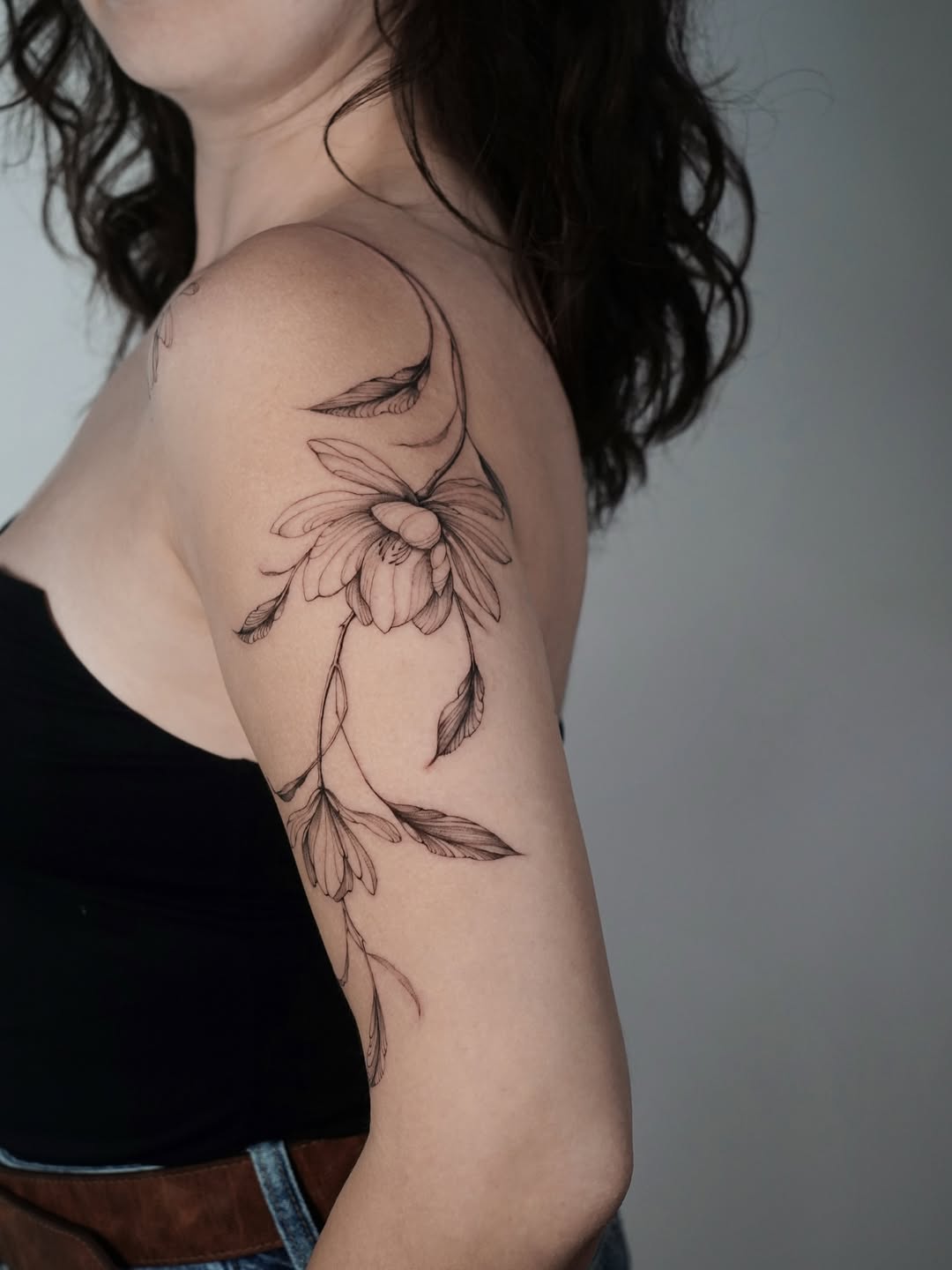
A graceful vine arcs over the shoulder and trails down the arm, petals opening like tiny paper fans. Linework stays crisp while interior shading stays airy, so the piece can extend into a half- sleeve later without feeling heavy now.
Why it works: The curve mirrors the clavicle and deltoid, creating natural armor that still feels feminine. Leaves are angled to suggest breeze—dynamic on every turn.
Style ideas: One-shoulder knits, strapless tops, or a soft linen blazer with rolled sleeves.
Bold Forearm Bouquet With Deep Leaf Contrast
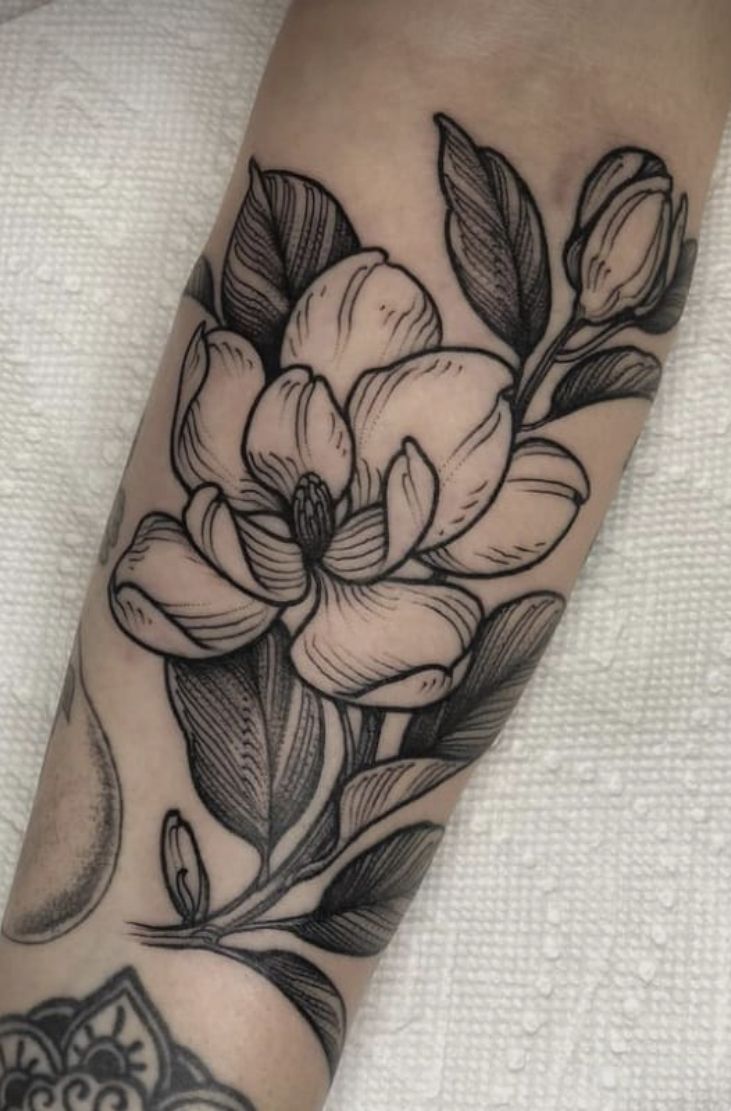
Thick contours and confident packing make this forearm magnolia impossible to miss. Petals are kept luminous with light interior shading, while leaves go nearly charcoal to frame the blooms. It leans toward heritage traditional structure—clear silhouette, readable from a distance—yet the interior textures feel contemporary.
Why it works: The dark-leaf/light-petal strategy creates depth without overworking the flower. Great anchor if you’re planning a forearm sleeve .
Style ideas: Rolled chambray, biker jacket, or knit polo. Let the grayscale be the outfit’s texture.
Small Thigh Sprig, Fineline & Quiet
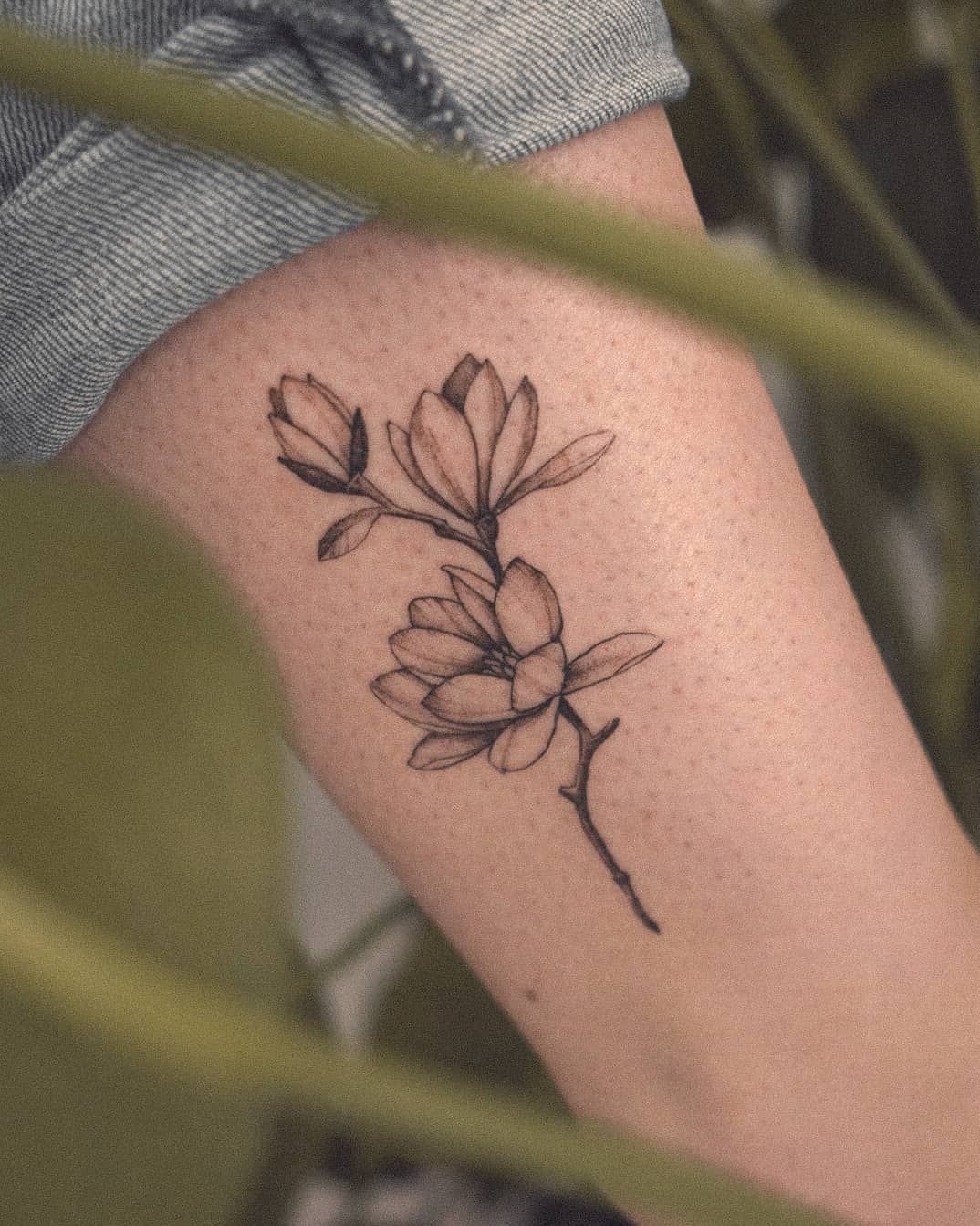
Two blossoms and a bud perch on a thin branch—minimal, intimate, and very fineline . The shading is soft pepper; outlines are light enough to age gracefully on the thigh.
Why it works: Negative space does the heavy lifting, so the piece stays simple and elegant even at small scale.
Style ideas: High-cut shorts, satin slip, or soft lounge sets. Works as a stand-alone or starter for a botanical cluster.
Neo-Traditional Magnolia With Evergreen Leaves
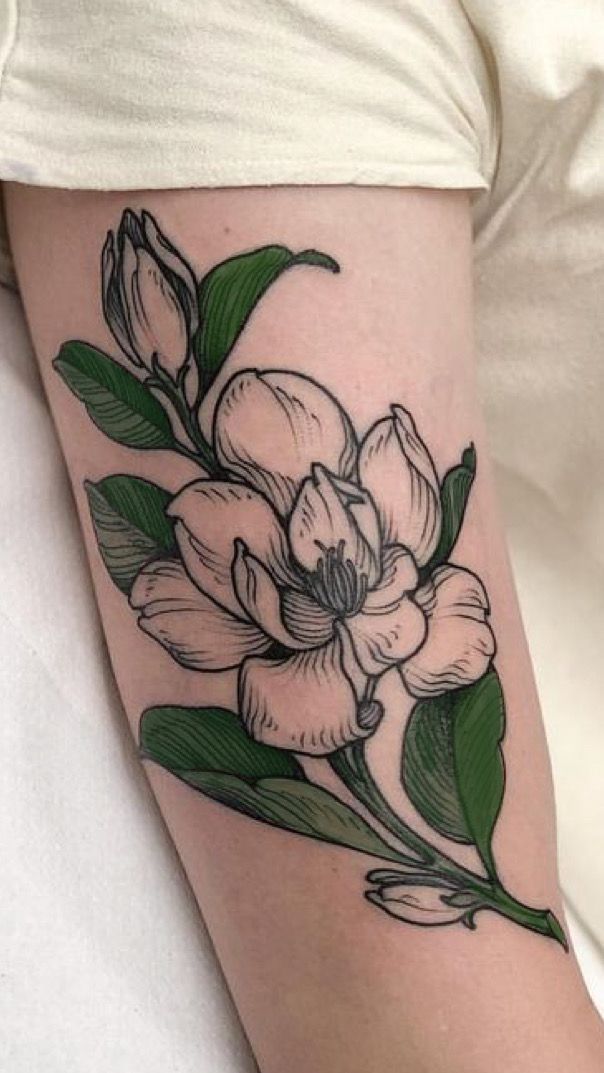
Creamy petals pair with bottle-green leaves and bold black lines—classic American traditional bones modernized with nuanced shading. The color blocking is tidy and durable; the outline weight ensures long-term legibility.
Why it works: Color is placed where the skin won’t rub constantly, and greens cool the warmth of the petals—balanced, refined color design .
Style ideas: White tees, denim, and canvas sneakers for a clean, graphic look.
Shoulder Cap Garland With Stippled Petals
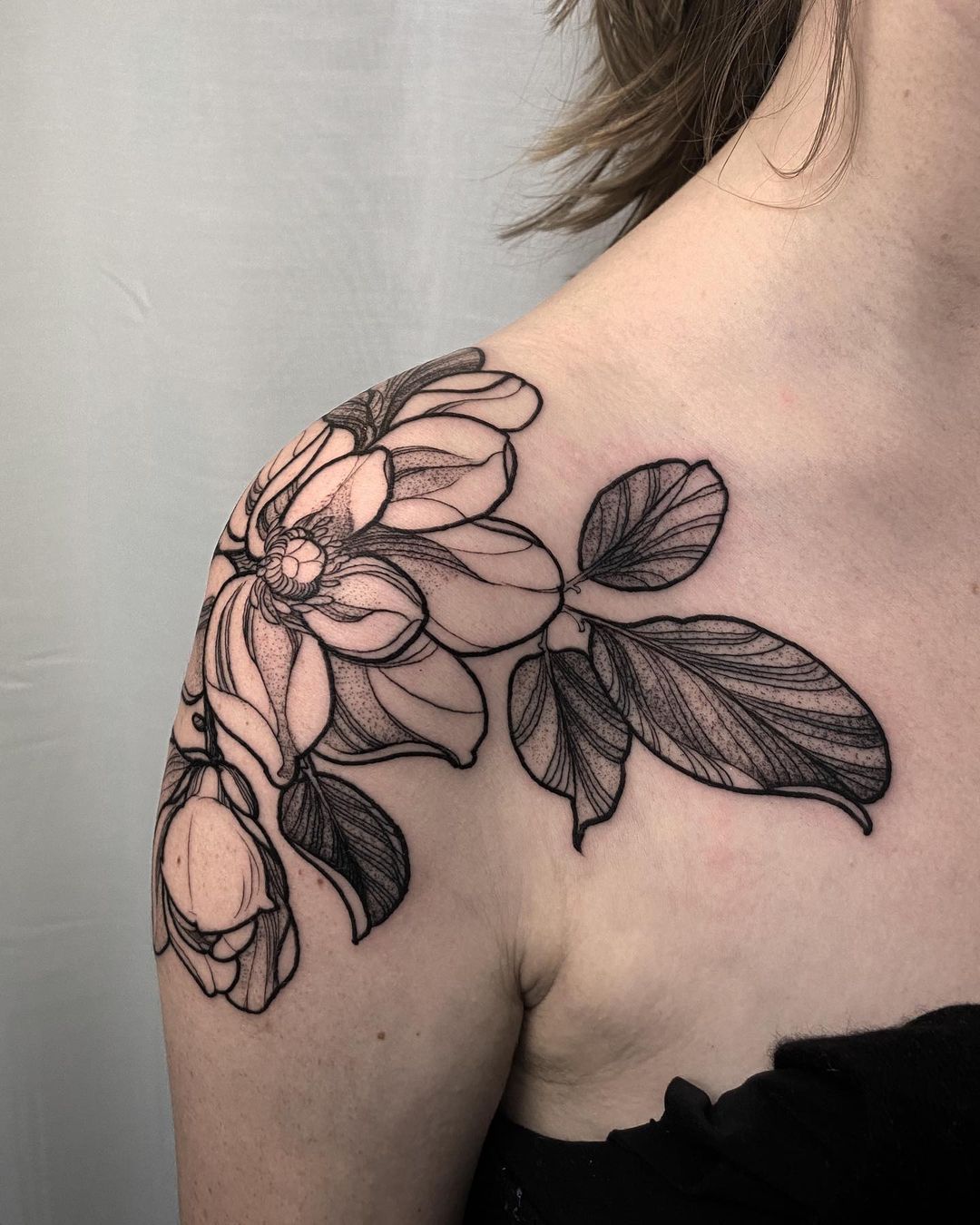
A generous bloom crowns the shoulder , trailed by buds and broad leaves. Stippled midtones inside the petals keep them glowing while leaves carry darker values. It’s armor-like without feeling heavy.
Why it works: Maps perfectly to the deltoid curve and invites future extension into a half- sleeve .
Style ideas: One-shoulder knits, camis with slim straps, off-the-shoulder dresses.
Wraparound Magnolia Band With Falling Petals
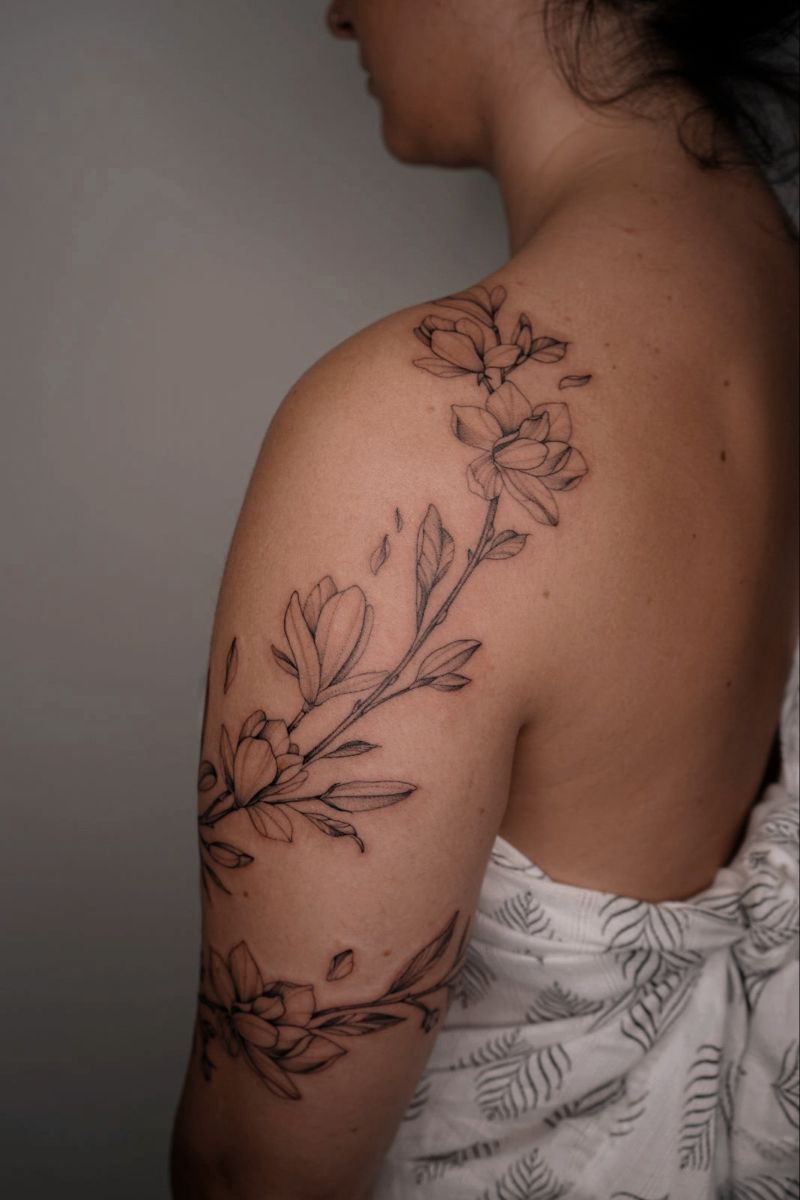
A slender branch circles the upper arm like botanical jewelry. Linework stays light; shading is feathered. Floating leaves and petals add motion—think breeze caught mid-turn.
Why it works: The “armband” placement elongates the bicep and offers built-in expansion points for a full sleeve later.
Style ideas: Strapless tops, halters, or a linen wrap dress for summer.
Back-of-Shoulder Branch In Soft Graphite
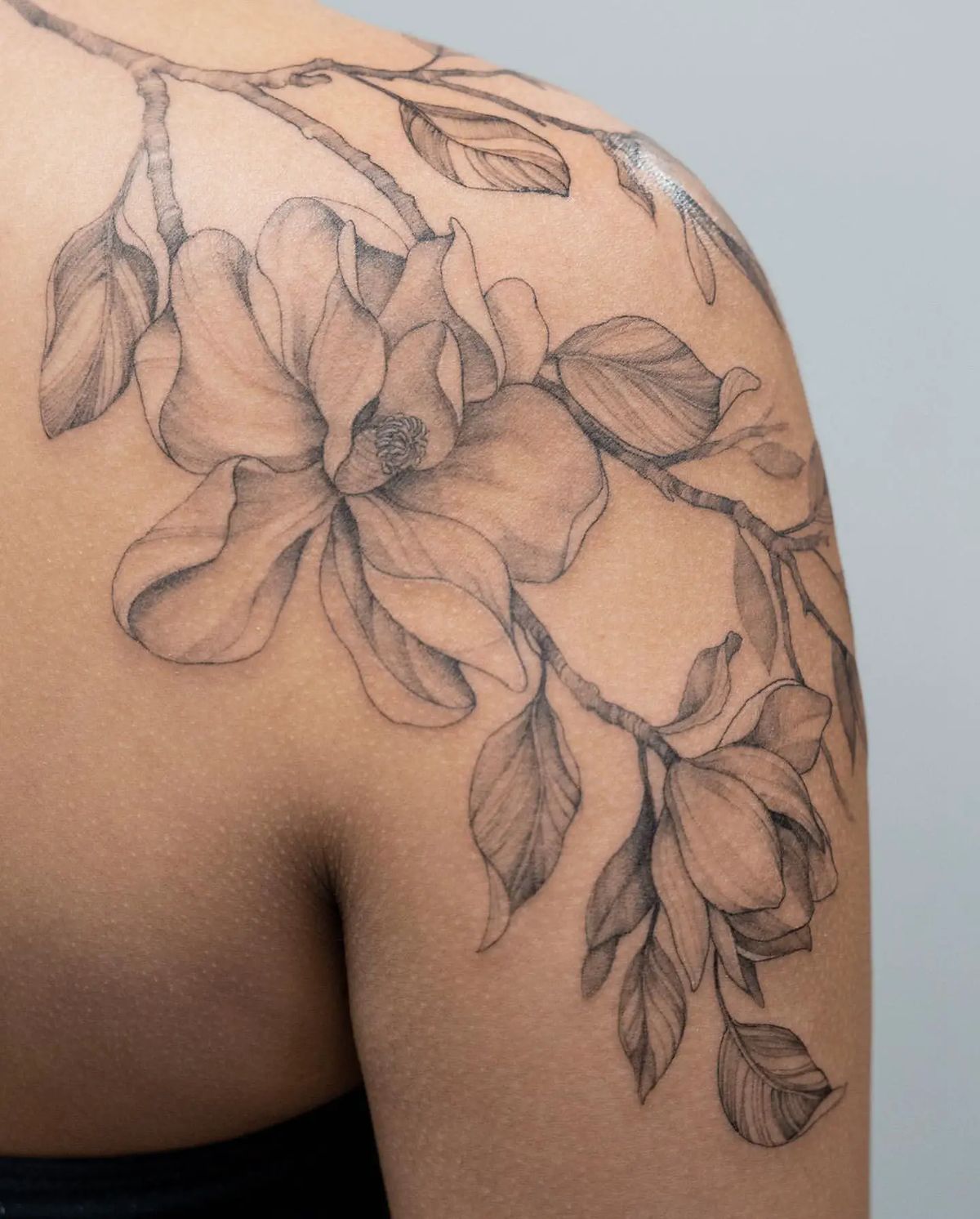
A naturalistic branch drapes the scapula with airy stipple shadows and delicate bark texture on the twigs. It reads like a botanical plate—subtle and sophisticated.
Why it works: The composition follows shoulder anatomy, so it looks native to the body whether arms are lifted or resting.
Style ideas: Low-back tanks, racer knits, and open cardigans.
Tiny Magnolia Near The Elbow—Sweet & Discreet
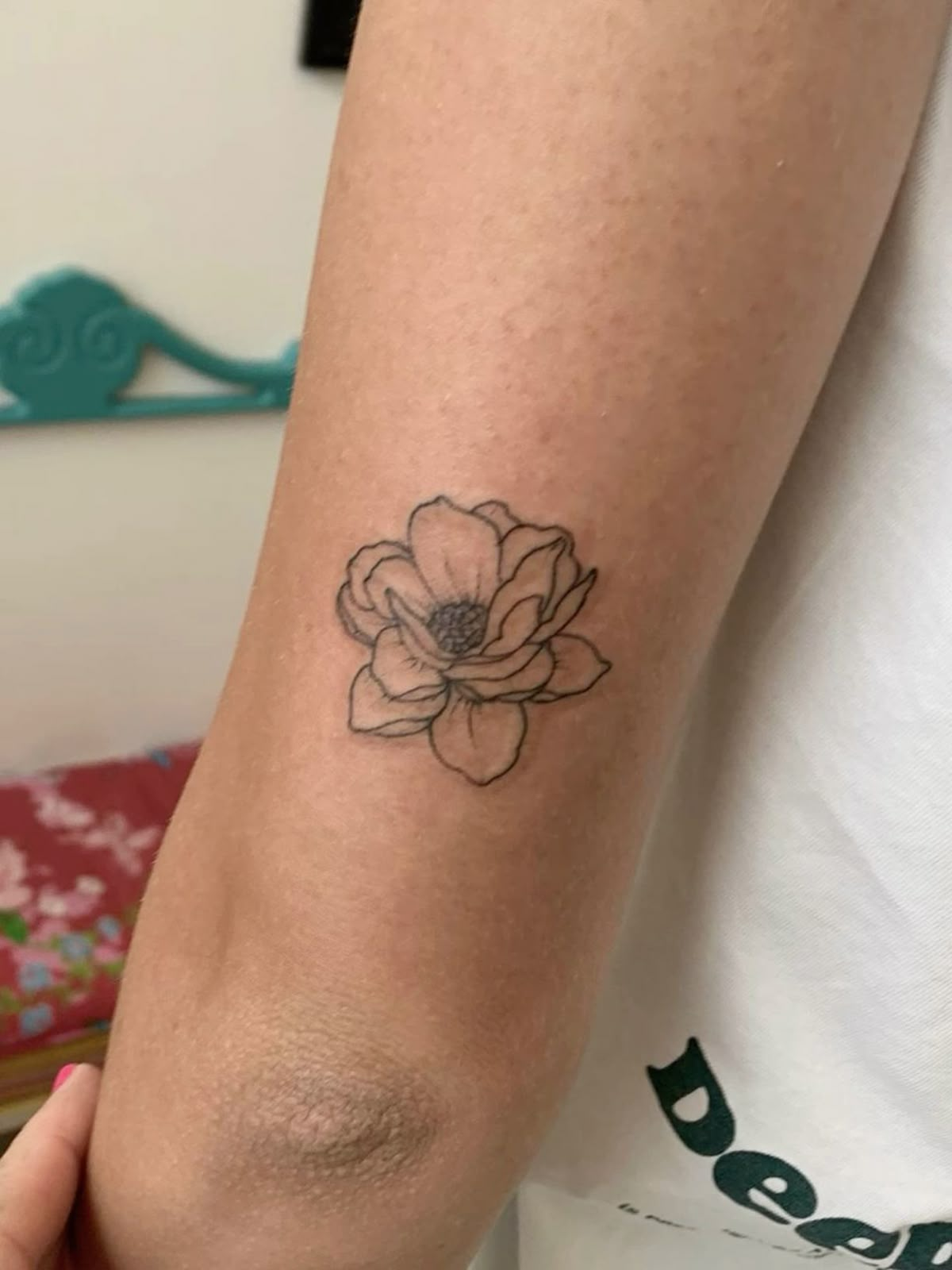
A coin-sized bloom sits near the elbow crease, crisp lines with a dusting of dotwork at the center. It’s a micro statement for anyone who prefers restraint or wants to test fine line florals before committing to scale.
Why it works: Small, centered shapes handle movement well at the elbow; the simple silhouette keeps it legible.
Style ideas: Rolled tees, delicate bracelets; treat it like a charm on your arm.
Magnolia sits at the sweet spot between strength and softness, which is why it works in almost any direction— fine line sprigs, softly shaded botanicals, crisp American traditional structure, delicate color pops, or a full sleeve that grows over time. The best results come from matching the design to your life: placement with low friction and sun, a stencil that respects your body’s curves, and a style that complements your wardrobe. I hope these magnolia tattoo ideas helped you picture what suits you—shoulder cap, back piece, minimalist forearm, or a bold Southern-inspired bouquet. Tell me in the comments what you’re leaning toward (fineline, traditional, pink accents, etc.), drop questions about sizing or aftercare, and share references from artists you love. Your stories—and healed photos—will inspire the next reader.
